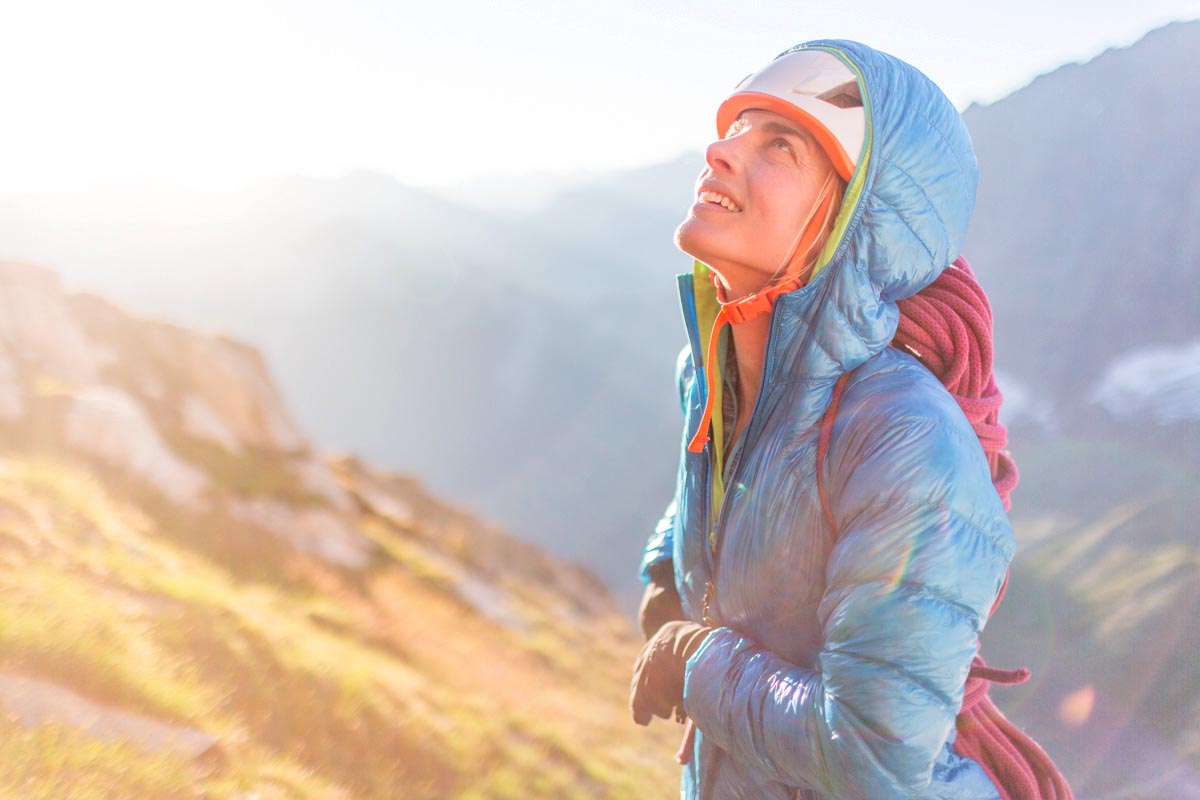
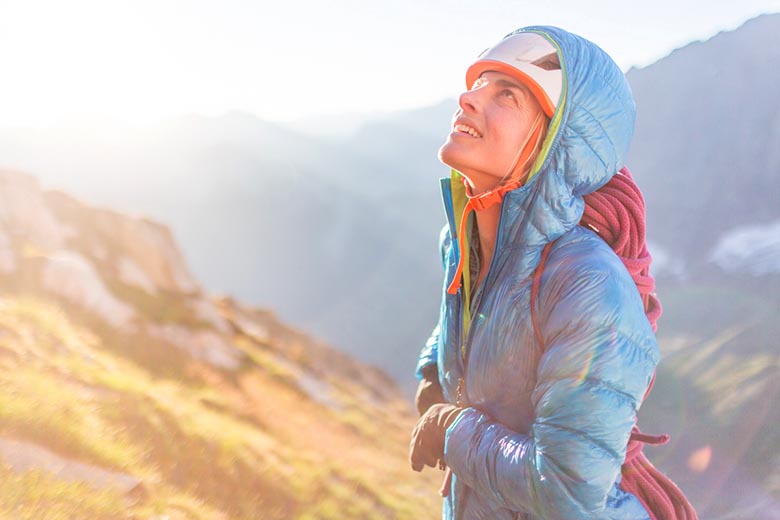
A climbing helmet is an essential piece of gear for outdoor climbing, whether you’re headed to the mountains or top-roping at the crag. Climbing helmets protect your head from both rockfall and side impacts (such as hitting your head during a lead fall) and prioritize comfort alongside a streamlined design. The best climbing helmet is the one on your head, but your decision will largely come down to materials, weight, and appearance. Our vertically inclined team has been testing climbing helmets for over a decade, from ultralight models for long alpine missions to tough and affordable options for new climbers, and below we break down our 13 favorites for 2025. For more information, see our comparison table and detailed buying advice below the picks, as well as additional details about our testing process.
Editor's note: This guide was updated on August 14, 2025, to remove the out-of-stock Edelrid Shield, add photos from recent testing trips, and expand some of the sections in our buying advice. We also combed through the guide to ensure prices, colorways, and products were current at the time of publishing.
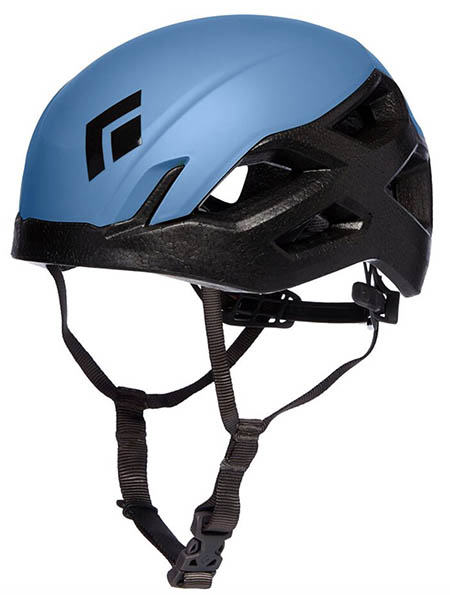 Weight: 7.6 oz. (size S/M)
Weight: 7.6 oz. (size S/M)
Construction: EPP & EPS w/ ABS shell
What we like: Lightweight, durable, and good-looking—all at a reasonable price point.
What we don’t: Not a standout in any metric.
If you were to tour all the climbing areas in the U.S., it’s unlikely that the Vision is the helmet you’d see most. That prize might go to the Petzl Sirocco or Black Diamond Half Dome below, which are both brilliant lids in their own right. But while the sleek Sirocco is a bit overkill for the crag and the budget Half Dome is heavy (and won’t earn you style points), the Vision does it all, with a low 7.6-ounce weight, attractive and durable partial-ABS shell, and mostly EPP foam construction (quick primer: EPP is pricer than EPS but absorbs impacts rather than shattering—more on this in our buying advice below). And at just $110, it’s a really great value.
But while the Vision is the best all-rounder, it’s not a standout in any metric. Black Diamond's own Vapor and the aforementioned Sirocco below are around 2 ounces lighter and significantly more streamlined, which makes them better options for long routes, redpoint attempts, or fast-and-light missions. And if durability is your main priority, there’s no match for a helmet like the Petzl Boreo or BD Capitan, both of which feature a full-coverage ABS shell along with similar EPP/EPS foam construction. But for those in the market for an all-rounder that’s at once lightweight, durable, good-looking, and relatively affordable, the Vision is the Goldilocks helmet that puts it all together. Black Diamond also offers a MIPS version ($150), which increases protection against angled impacts.
See the Black Diamond Vision
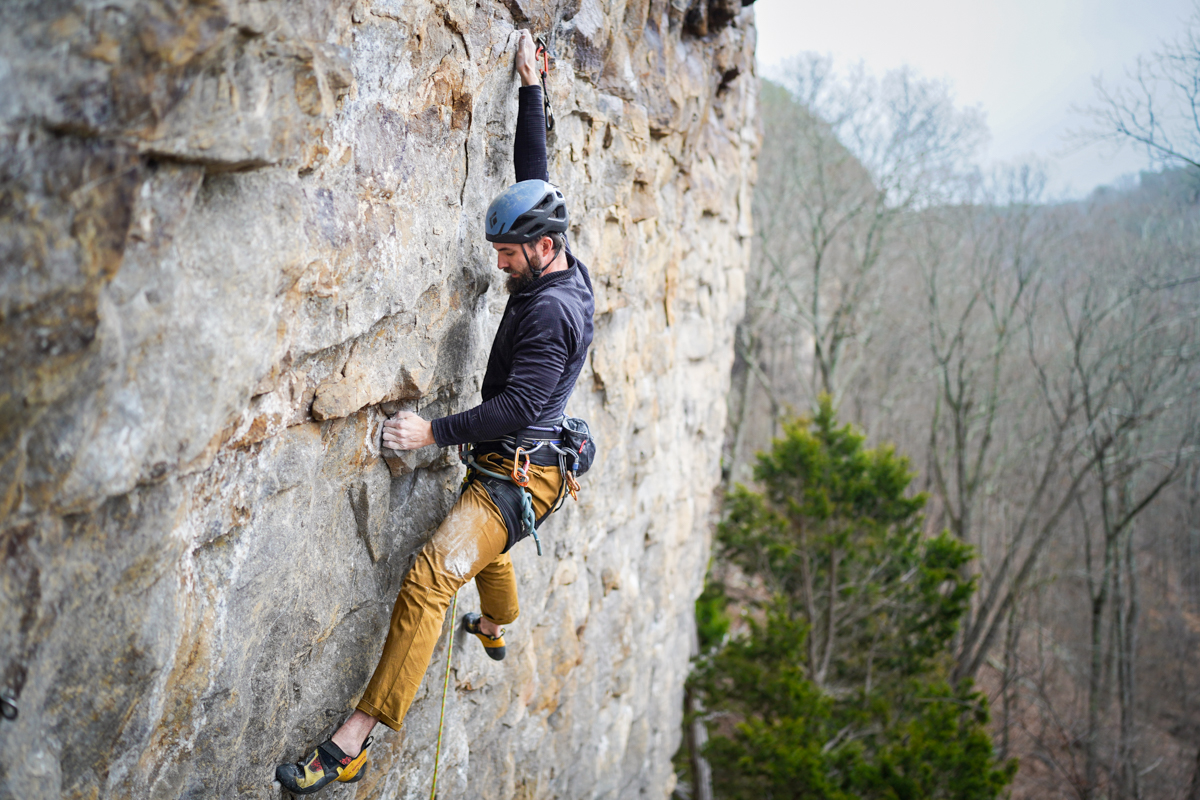
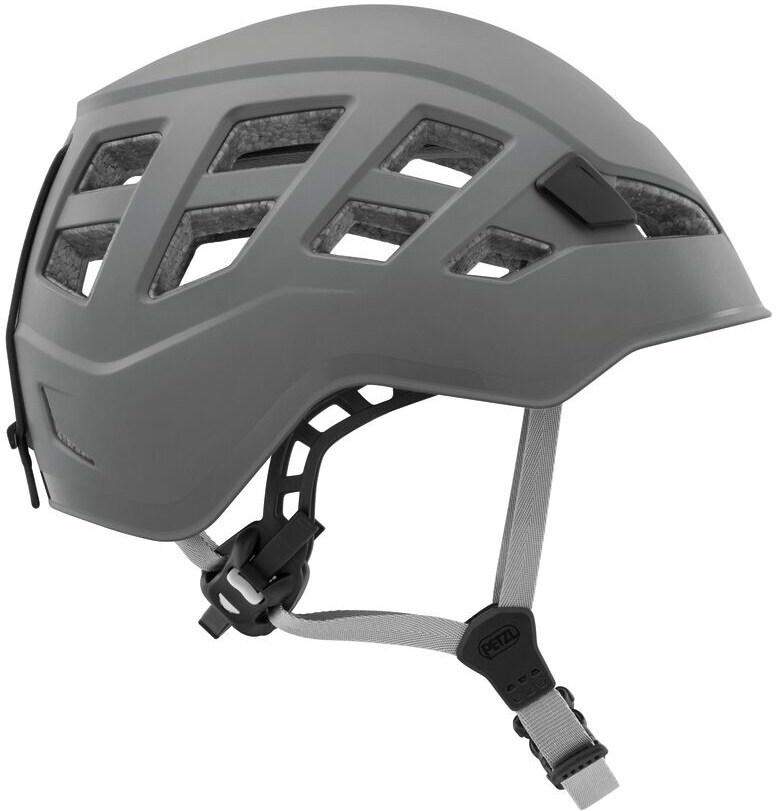 Weight: 10.6 oz. (Boreo size S/M), 10.7 oz. (Borea)
Weight: 10.6 oz. (Boreo size S/M), 10.7 oz. (Borea)
Construction: EPP & EPS w/ ABS shell
What we like: A very durable entry-level helmet that's available in both men's and women's styles.
What we don’t: Inferior adjustments compared to the Black Diamond Half Dome.
Because protection is a given (every helmet here meets the same certification for safety), beginner climbers should have one main priority when it comes to shopping for a helmet: price. And here’s the good news: Not only is the Boreo one of the cheapest helmets here at $75, but it’s also one of the most durable. Constructed with an ABS shell and featuring both EPS and EPP foam, you get maximum impact protection at both the top and sides. In other words, the Boreo is constructed with the most robust shell material and some of the most durable foam, making it among the most reliable helmets here. You can throw this thing around, stuff it at the bottom of your climbing pack, and use it and abuse it for years, and it’ll just keep trucking.
Not only is the Boreo one of the hardest-wearing and most affordable climbing helmets, but it’s also relatively light for an entry-level model (1 oz. lighter than the Half Dome below). Further, you get generous venting for hot weather and a suspension system that nests nicely in the crown of the helmet. We do think that Petzl could improve the suspension, as the two-handed adjustment and fixed straps under the ears aren’t as user-friendly as the click wheel and adjustable straps on the Half Dome. But the benefits far outweigh these minor downsides, and the Boreo (and women’s-specific Borea) is our top pick for budget-oriented shoppers. Coming in at a close second is the BD Capitan below, which matches the Petzl in durability and price while tacking on a bit more style.
See the Men's Petzl Boreo See the Women's Petzl Borea
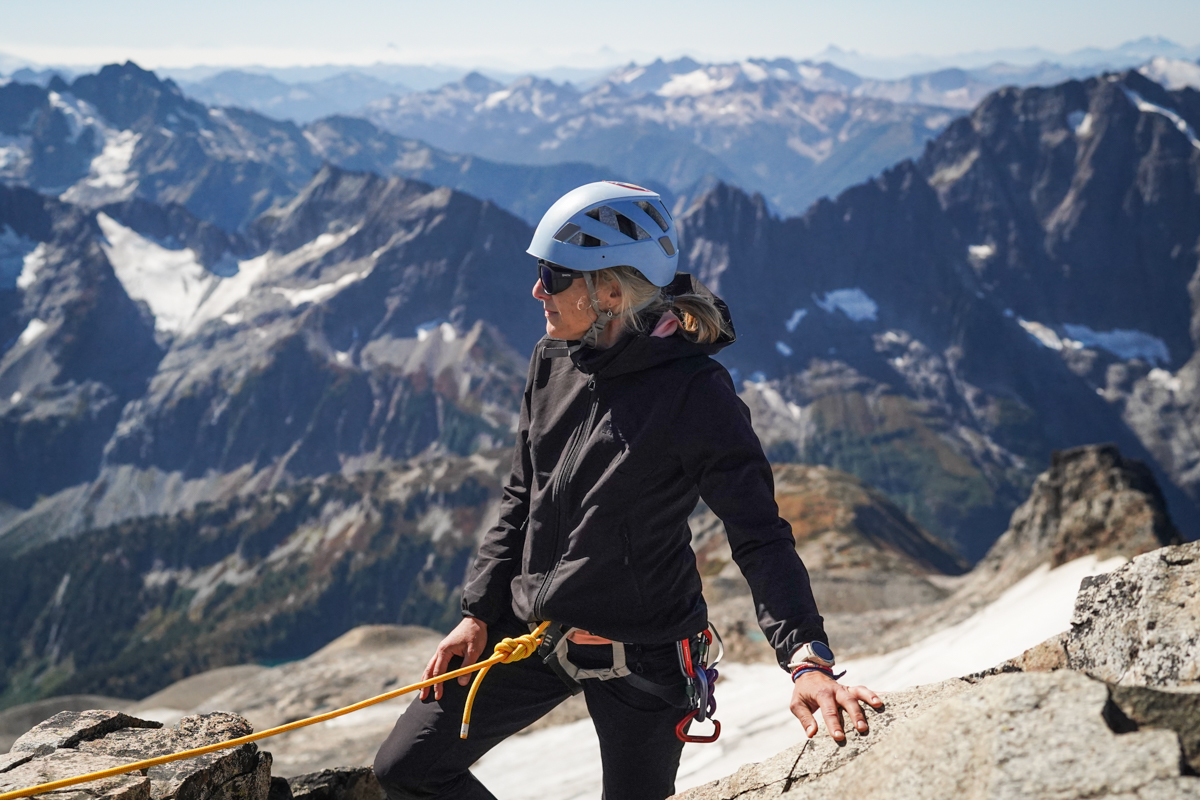
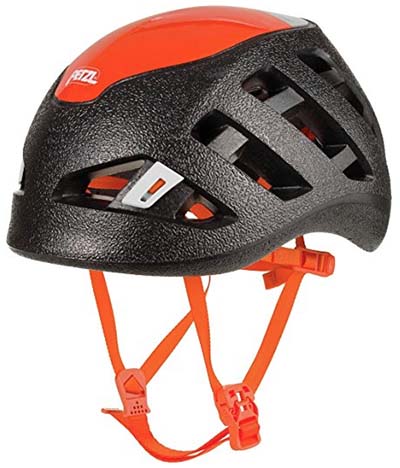 Weight: 5.6 oz. (size S/M)
Weight: 5.6 oz. (size S/M)
Construction: EPP & EPS w/ polycarbonate shell
What we like: Ultralight, comfortable, and vents well.
What we don’t: Magnetic chin buckle can clog with dirt.
The original Petzl Sirocco shook up the climbing world with its lightweight yet durable construction and soon earned the endorsement of many serious alpinists. The second version builds off the first, with similar fundamentals but a more traditional shape and palatable look. Like the Black Diamond Vision above, the Sirocco uses a combination of expanded polypropylene (EPP) and expanded polystyrene (EPS), but with a smaller polycarbonate shell and a lower-profile design, it weighs 2 ounces less. In fact, this helmet is so feathery light that you’ll forget it’s on your head.
The Sirocco is the ideal helmet for ounce-counting climbers, and its fairly streamlined shape fits well at the top of a small pack, too. It’s also certified for ski touring, which places it in an exclusive category along with the CAMP Speed Comp and Petzl Meteor below. We will note that we’ve been less than impressed with the Petzl’s magnetic chin buckle and rear cinch, which have a tendency to loosen or come undone while climbing. But the lightweight build and small packed size nevertheless make the Sirocco our go-to choice for everything from mountain traverses to involved Patagonian climbs, and the suspension offers a much better fit than the wobbly Vapor below.
See the Petzl Sirocco Helmet
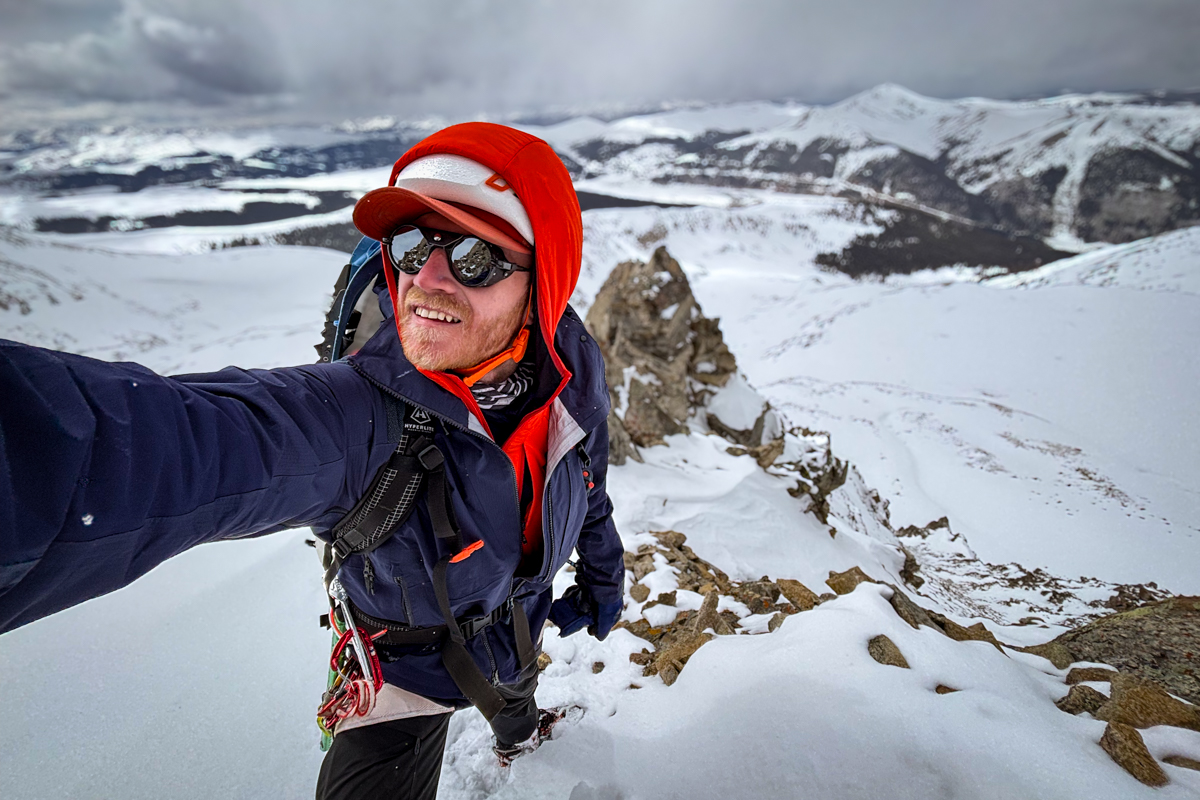
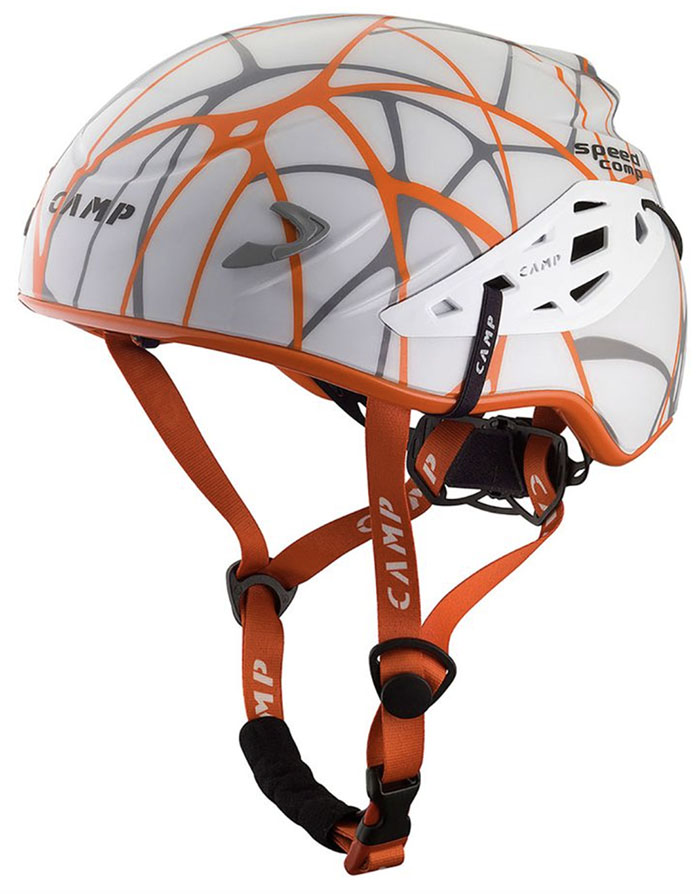 Weight: 12.4 oz.
Weight: 12.4 oz.
Construction: EPS w/ polycarbonate shell
What we like: A well-executed two-in-one option for climbing and skiing.
What we don’t: Heavy if you’re looking for a high-performance, climbing-specific helmet.
For those who split their time between skiing and climbing (or who blend the two), it's worth considering a helmet that can keep up with both disciplines. Among a growing number of dual-rated helmets, the CAMP USA Speed Comp stands out as our favorite: It's sure to protect you on the rock but also doubles as an alpine skiing and skimo-racing lid. Unlike the Petzl Meteor (below) and Sirocco’s ski-touring certification, its beefy build offers more protection and earns it an EN 1077 rating, which is the standard for most ski helmets. It also features a relatively thick external shell, making it slightly more durable than most EPS models listed here.
However, there are some trade-offs to the CAMP's multi-purpose design. While lightweight on the slopes, the Speed Comp is on the heavy side for an in-mold climbing helmet. Additionally, some won't love the non-traditional style and rounder shape, although it's worth trying if the Black Diamond or Petzl helmets don't fit your head well. In the end, we recommend the Speed Comp only if you spend significant time transitioning between climbing and skimo and are looking for a helmet to pull double duty. If your focus is primarily on ski touring, the Petzl Meteor below is much lighter and cheaper.
See the CAMP USA Speed Comp
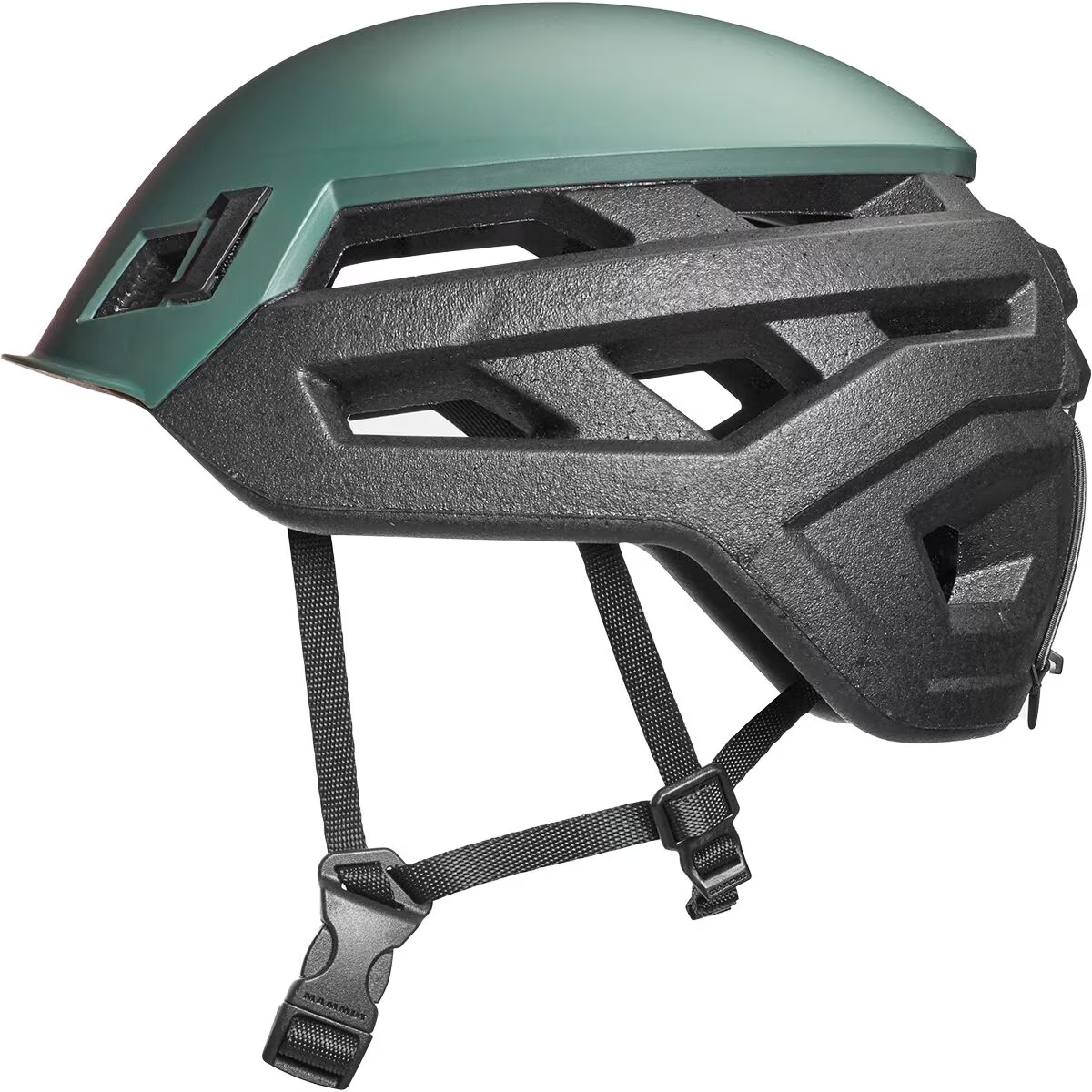 Weight: 6.9 oz. (size S/M)
Weight: 6.9 oz. (size S/M)
Construction: EPP w/ polycarbonate shell
What we like: Lightweight, durable, and sleek design.
What we don’t: Webbing adjustment isn’t very intuitive.
The Mammut Wall Rider is one of the most premium helmets in the game, combining minimal weight, great coverage, and durable construction and materials. Like the Sirocco and Vision above, it uses EPP foam covered with a lightweight polycarbonate shell, resulting in a helmet that offers full coverage and nice all-around impact protection. To top it off, the Mammut is a great-looking lid—we especially love the bill—and comes with a long track record of success both in the alpine and at the crag.
Choosing between the Wall Rider and the Black Diamond Vision above can be a tough call, especially considering their matching price tags. On one hand, the Wall Rider is an ounce lighter than the Vision—making it the better choice for all-day missions—and we love the overall look and shape. On the other hand, we found the Mammut's simple webbing adjustment more difficult to use than the Vision's intuitive plastic slider. In the end, a final decision might come down to fit, and we recommend trying on both to see which is more comfortable for you. And like the Vision, the Wall Rider is also available in a MIPS version.
See the Mammut Wall Rider
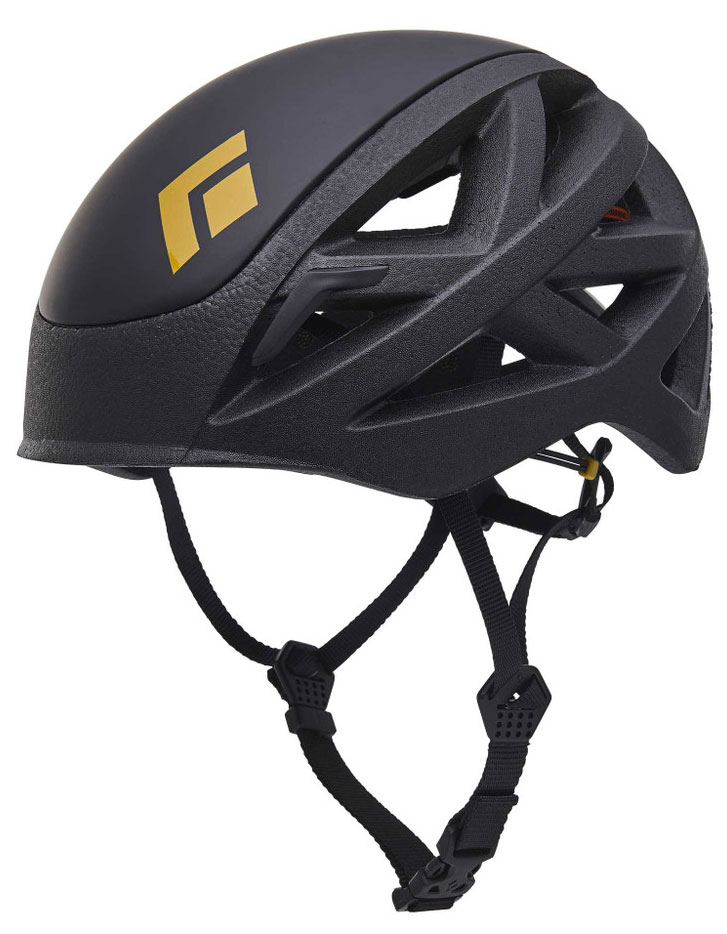 Weight: 5.5 oz. (S/M)
Weight: 5.5 oz. (S/M)
Construction: EPP & EPS w/ polycarbonate shell
What we like: Chin buckle is much more confidence-inspiring than the Sirocco’s.
What we don’t: Pricier than the Sirocco; difficult to lock in a good fit.
Black Diamond’s Vapor has been their high-end helmet for years running, lauded for its low weight, great ventilation, and even better looks. That said, it hasn’t historically been the most durable lid—we’ve cracked (and retired) two Vapors throughout the past decade, which has made the steep price tag hard to swallow. But recently, the classic helmet received a modern makeover, complete with EPP foam and an ultralight composite that goes by the name of ALUULA. The result: The latest Vapor is now incredibly lightweight at 5.5 ounces, very durable, and just about as good-looking as before. And like the Petzl Sirocco above and Meteor below, it boasts a CE rating for ski touring.
The Vapor and Sirocco both use a combination of EPP and EPS foam with a polycarbonate shell. The only way they could be more durable with today’s tech would be to use a more hardwearing (and heavier) ABS shell, like what you get with the Boreo above or BD's own Capitan below. What’s more, the two helmets are virtually the same weight: On our scale, the Black Diamond is a scant 1 gram lighter (that’s 0.04 oz.). The primary difference comes in terms of fit: Both suspension systems are very streamlined, but the Vapor’s is much more squirrely and difficult to adjust—our helmet is almost always catawampus on our head (on the flip side, we definitely appreciate the BD’s more secure chin buckle). Both are high-quality ultralight designs from two of the best names in the business, but we give the slight edge to the Petzl for its lower price and better fit.
See the Black Diamond Vapor
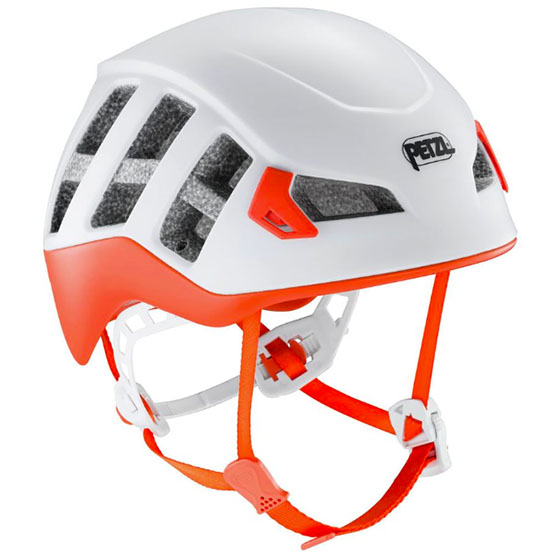 Weight: 7.9 oz. (size S/M)
Weight: 7.9 oz. (size S/M)
Construction: EPS w/ polycarbonate shell
What we like: A 4-season climbing helmet at a great price; fit is accommodating and easy to adjust.
What we don’t: EPS foam is more fragile than the Sirocco’s EPP.
Petzl's Meteor is a head-turner and one of our favorite helmets of the year. Most notably, it was the first-ever CE-certified ski touring helmet (the Sirocco joined this category soon after) with a shape that accommodates ski goggles—including a rear attachment—and a high-quality adjustment system that expands to fit a beanie underneath. The Meteor also features generous coverage down the neck and great ventilation throughout. All in all, this high-quality lid is the full package for 4-season mountain-goers, and it’s pretty reasonably priced.
With ski-touring versatility, great coverage, and a competitive price point, the Meteor is our favorite EPS dome with a polycarbonate shell. But there are some inherent downsides to this construction: Namely, EPS foam is less durable and protective than the more modern EPP found in helmets like the Petzl Sirocco and Black Diamond Vapor above. As a result, you’ll want to be sure to treat the Meteor gently to maximize its lifespan. But the Petzl is still an incredible value, and its suspension system is a lot easier to adjust than that of the Sirocco or Vapor (including a rear ratchet and under-the-ear adjusters).
See the Men's Petzl Meteor See the Women's Petzl Meteora
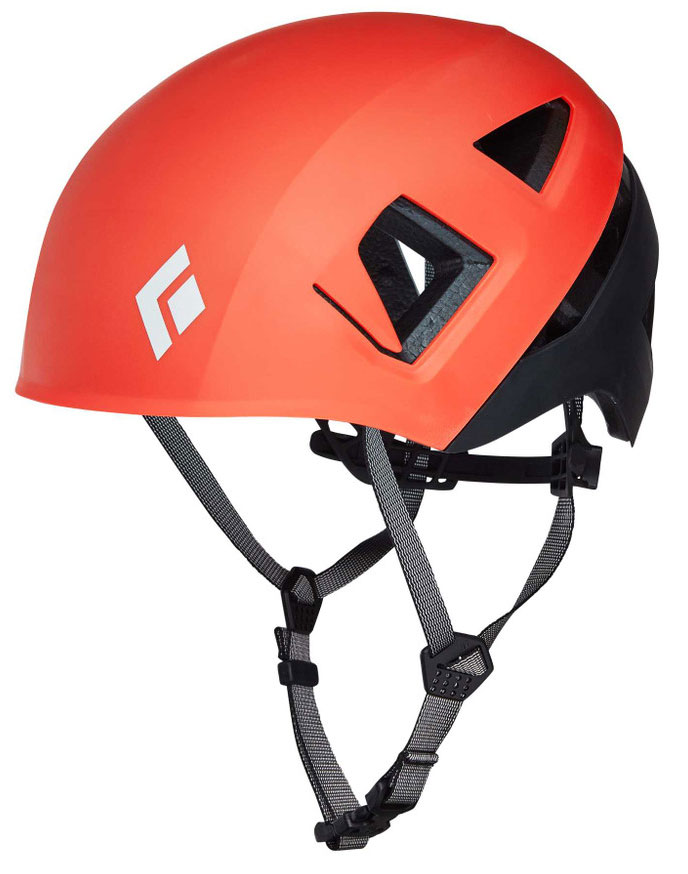 Weight: 10.4 oz. (S/M)
Weight: 10.4 oz. (S/M)
Construction: EPP & EPS w/ ABS shell
What we like: Affordable and durable with the looks of a premium helmet.
What we don’t: Hard to get a good fit.
Released in 2022, the Capitan slides into Black Diamond’s lineup right in between the Vision above and Half Dome below. This helmet prides itself on being tough, with a long-lasting ABS hardshell and springy EPP foam, along with extended coverage along the sides and back of the head. But it’s not just a knock-around lid—the Capitan also features an attractive dual-shell construction that adds the appearance of a premium helmet to the bones of a more budget-friendly design. All told, it’s a great option for the climber who prioritizes maximum protection and a good dose of coverage but is willing to spend a tad more than the Half Dome for a bit more durability and style.
Like the Petzl Boreo above, the Capitan isn’t uber-lightweight, so we don’t necessarily recommend it for weight-conscious mountain missions or nail-biting redpoint burns. But for big wall climbing (such as on the Capitan's namesake in Yosemite) or winter ascents where you anticipate taking a lot of ice to the head, it’s a durable workhorse that doesn’t look out of place among the more premium designs here. A key disappointment is with fit: Black Diamond hasn’t been nailing the suspension system in their recent updates (including the Vapor above), and the Capitan is yet another casualty. But if it’s a good match for your noggin, there’s a lot to like about BD’s ultra-durable lid. Finally, it also comes in a MIPS version for $120—one of the cheapest MIPS-equipped climbing helmets on the market—though stock appears to be waning at the time of publishing.
See the Black Diamond Capitan
.jpg) Weight: 7.4 oz.
Weight: 7.4 oz.
Construction: EPP w/ ABS shell
What we like: A lightweight and well-made helmet.
What we don’t: Heavier and more expensive than the Vision above.
The Edelrid Salathe is not the lightest or most durable helmet on this list, but it might offer the best combination of the two. For just 7.4 ounces, you get the same EPP foam that we see in many of our top picks (known for its ability to bounce back—rather than crack—upon impact), along with a robust ABS hardshell on top. In other words, the Salathe takes the design of the chart-topping Petzl Sirocco and swaps out the polycarbonate crown for a hardshell, which tacks on a couple ounces but offers a boost in durability.
Adding a shell to an EPP helmet is more cosmetic than anything, allowing the helmet to be shaped more like a dome and less like a cone (for proof, just look up images of the first-generation Sirocco). In other words, the Salathe's ABS shell doesn't add significantly more protection than the Sirocco's polycarbonate top, although it will do a better job fending off cracks and dents—you'll just have to decide if it's worth it for the 1.8-ounce weight penalty. In terms of weight, the Edelrid is right on par with the 7.6-ounce Vision, which features an easier-to-use adjustment system. But there's a lot to like about the Salathe, and it even includes a CE rating and goggle-friendly shape for ski touring.
See the Edelrid Salathe
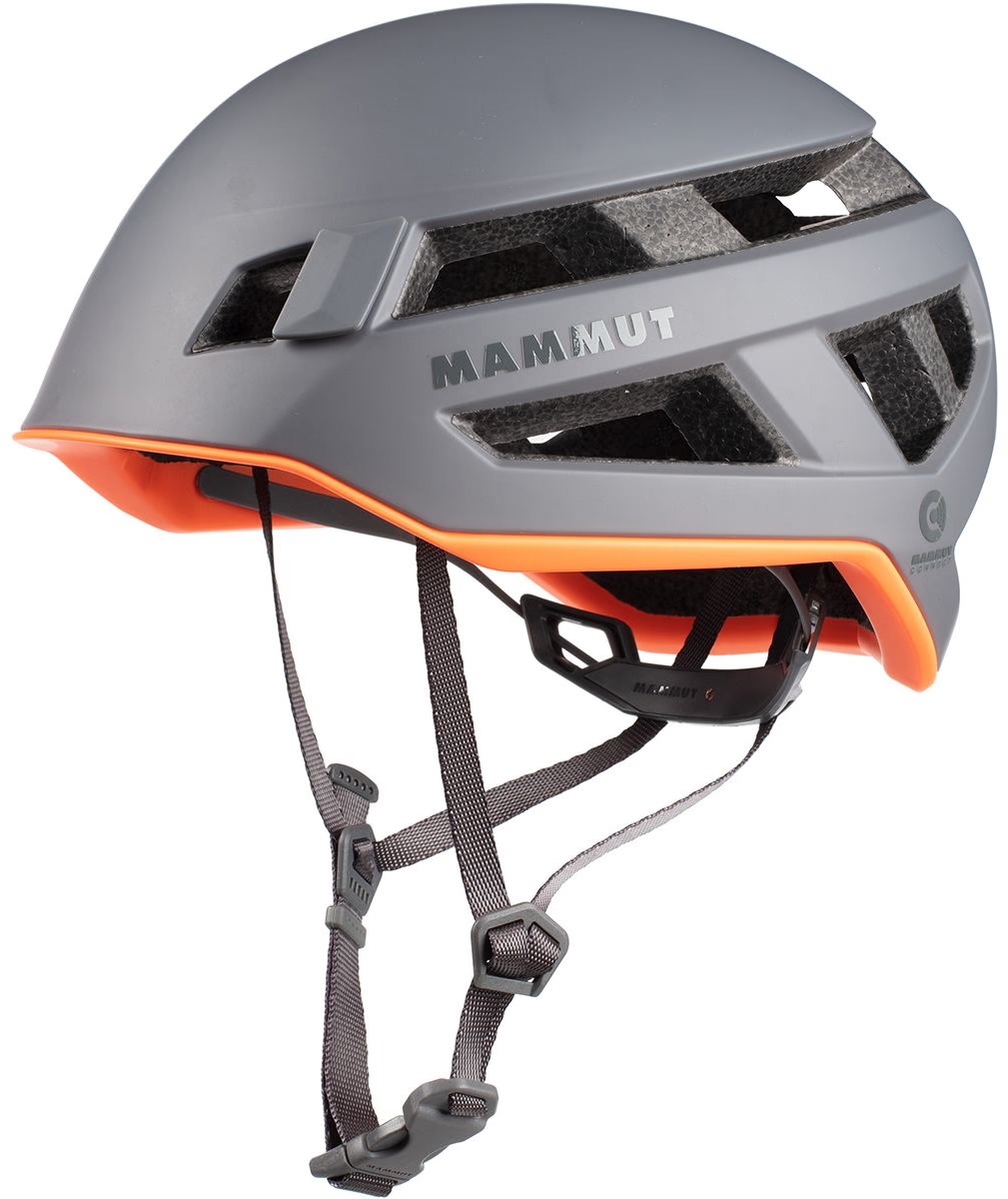 Weight: 7.4 oz.
Weight: 7.4 oz.
Construction: EPS w/ polycarbonate shell
What we like: Light and low-profile but highly protective.
What we don’t: Not the most durable option for the price; webbing straps are tough to adjust and may cause discomfort for some.
The Mammut Crag Sender echoes much of what we love about Black Diamond’s Vision and Capitan above: It’s affordable, low-profile, and looks good to boot. It’s also competitively lightweight at 7.4 ounces, undercutting both of those options by 0.2 and 3 ounces, respectively. But what truly sets the Crag Sender apart is its construction: Mammut opted for a lightweight polycarbonate shell (rather than thicker and more durable ABS) with EPS foam but reinforced key areas with Kevlar—the same high-strength material used in bulletproof vests. In other words, the Crag Sender packs a real punch despite its streamlined construction, making it well suited for effortful redpoint burns when you want reliability alongside a barely-there feel.
Similar to our experiences with the Capitan, we encountered some fit issues with the Crag Sender. Specifically, the webbing straps are difficult to adjust, which led to discomfort and irritated ears after a few hours of climbing (some users have also noted that the edge of the helmet tends to rub the tops of their ears, although we haven’t experienced this). Additionally, despite the Kevlar reinforcements, the Crag Sender is less durable than competitors that use EPP foam and ABS shells—like what you get with the Capitan, Vision, and many others here. But we can’t help but love the Mammut’s light and well-ventilated build, and the approachable price tag is the cherry on top.
See the Mammut Crag Sender
.jpg) Weight: 11.6 oz. (size S/M)
Weight: 11.6 oz. (size S/M)
Construction: EPS w/ ABS shell
What we like: Affordable, dependable, and well-fitting.
What we don’t: Heavier and less durable than the Petzl Boreo above.
With new climbers flocking to the sport, we’d be remiss not to give a nod to Black Diamond’s tried-and-true Half Dome. This helmet isn’t groundbreaking in any particular way, nor is it the lightest or most comfortable model on the market. But it’s affordable, reliable, and will protect your head from falling rocks—and that’s what matters most. Additionally, the updated rear dial offers incredibly easy adjustment—better than the Boreo above—and Black Diamond also makes a dedicated women’s version with more venting and a ponytail-friendly design.
It’s all about protection and toughness here: The Half Dome’s heavy ABS plastic shell can absorb a sizable impact on its own without damaging the softer EPS foam inside, unlike helmets with lighter and less durable polycarbonate shells (the Petzl Meteor above, for example). But for the same price, the Petzl Boreo adds EPP foam for even greater durability, and BD's own Capitan above features a similar design with a more premium aesthetic. But as a quality helmet at a low price point, the Half Dome still is a top choice for climbers looking to venture outdoors without breaking the bank.
See the Black Diamond Half Dome See the Women's Black Diamond Half Dome
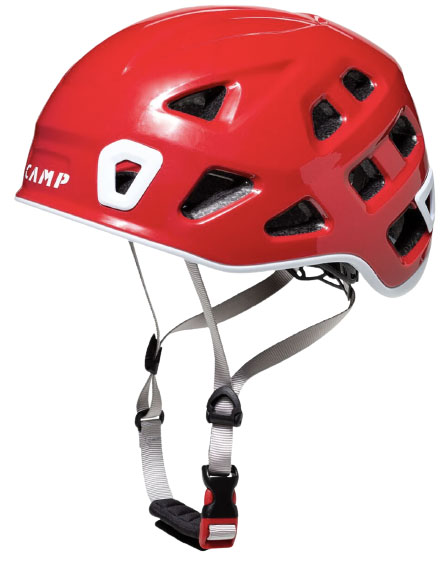 Weight: 8.1 oz. (48-56 cm)
Weight: 8.1 oz. (48-56 cm)
Construction: EPS w/ polycarbonate shell
What we like: Fits well and is highly adjustable.
What we don’t: Heavier and less versatile than other models in its price range.
CAMP USA has made plenty of functional and durable helmets over the years, but until recently, they haven’t earned many style points. The Storm is a good start: It’s available in six color combinations and includes an internal adjustment system that keeps it snug and close to the head. It also takes a few pointers from CAMP's Speed Comp above, resulting in a comfortable, lightweight, and well-ventilated climbing helmet that is made for just about any type of mountain adventure.
The CAMP Storm’s makeup is similar to many helmets on our list that combine EPS foam with a polycarbonate shell. It’s about the same weight as Petzl and Black Diamond’s comparable offerings above. But without the Meteor’s ski-touring functionality or the Vision's EPP foam, it falls short of the competition. That said, the Storm does fit a broad range of head sizes and shapes and comes with a well-designed adjustment system. We know it’s hard to choose among all of these options, but if you’ve struggled to find a helmet that fits well, the Storm is a good option to consider.
See the CAMP USA Storm
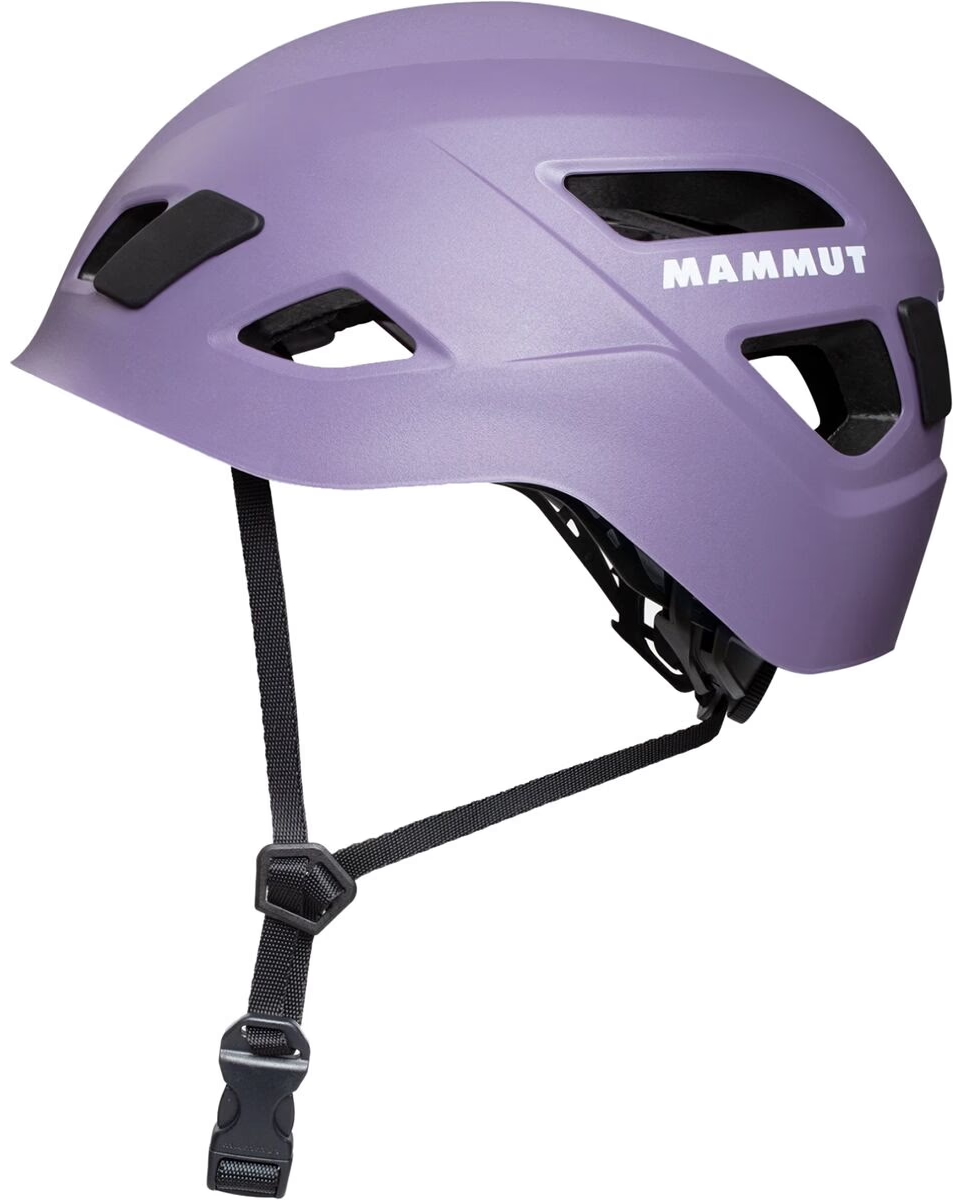 Weight: 11.6 oz.
Weight: 11.6 oz.
Construction: EPP & EPS w/ ABS shell
What we like: Affordable and well made, including durable EPP foam.
What we don’t: Doesn’t measure up in terms of fit, ventilation, and weight.
The Skywalker is Mammut’s entry-level offering, featuring a modern combination of EPP and EPS foam with an ABS hardshell. Like the Petzl Boreo above, this is a long-lasting and durable helmet for new and casual climbers or those who like to get a lot of life out of their gear. It’s not particularly lightweight or flashy, but the Skywalker 3.0 gets the job done and offers nice additions like easy-to-adjust suspension, plush foam padding, and large vents.
That said, the Skywalker 3.0 isn’t our first (or even third) recommendation among budget designs. The primary reason is that it only comes in one size, which for us is a dealbreaker in its own right. In fact, we'd be quicker to recommend the less durable Half Dome above (which uses EPS foam) for its better fit and finishes for both male and female climbers. What's more, at 11.6 ounces, the Skywalker is heavier than competing helmets, which can add up throughout a day at the crag. But for those who like the idea of durable EPP foam and aren't keen on the Boreo or BD Capitan above, the Mammut nevertheless is a serviceable alternative.
See the Mammut Skywalker 3.0
| Helmet | Price | Weight | Foam | Shell | Adjustment | Ski Cert |
|---|---|---|---|---|---|---|
| Black Diamond Vision | $110 | 7.6 oz. | EPP & EPS | ABS | Rear ratchet | No |
| Petzl Boreo | $75 | 10.6 oz. | EPS & EPP | ABS | Rear ratchet | No |
| Petzl Sirocco | $160 | 5.6 oz. | EPP & EPS | Polycarbonate | Webbing | Yes (touring) |
| CAMP USA Speed Comp | $140 | 12.4 oz. | EPS | Polycarbonate | Rear dial | Yes (skimo/ resort) |
| Mammut Wall Rider | $100 | 6.9 oz. | EPP | Polycarbonate | Webbing | No |
| Black Diamond Vapor | $170 | 5.5 oz. | EPP & EPS | Polycarbonate | Webbing | Yes (touring) |
| Petzl Meteor | $115 | 7.9 oz. | EPS | Polycarbonate | Rear ratchet | Yes (touring) |
| Black Diamond Capitan | $70 | 10.4 oz. | EPP & EPS | ABS | Rear ratchet | No |
| Edelrid Salathe | $110 | 7.4 oz. | EPP | ABS | Webbing | Yes (touring) |
| Mammut Crag Sender | $100 | 7.4 oz. | EPS | Polycarbonate | Rear dial | No |
| Black Diamond Half Dome | $65 | 11.6 oz. | EPS | ABS | Rear dial | No |
| CAMP USA Storm | $100 | 8.1 oz. | EPS | Polycarbonate | Rear dial | No |
| Mammut Skywalker 3.0 | $70 | 11.6 oz. | EPP & EPS | ABS | Rear dial | No |
The staff at Switchback Travel is serious about climbing, whether we're working through tough moves at our local crag, tackling long alpine routes in the North Cascades, or hoofing it up massive peaks in Nepal. We're also serious about safety, and like belay devices and climbing ropes, we've rigorously tested the helmets on the list above before recommending them. When evaluating these lids, we focus on three critical factors: safety, comfort, and style. For safety, we assess construction details such as foam and shell type, as well as overall head coverage. Evaluating comfort involves examining weight, fit adjustments, and ventilation. Finally, while entirely subjective, we know that style can be a deciding factor for many, which is why we included a range of options to suit different preferences and head shapes.
This list began in 2013 with three helmets hand-picked by freelancer Chris Kalman. Chris splits his time between putting up first ascents in climbing areas around the world, writing for various climbing magazines, and co-hosting the American Alpine Club’s Cutting Edge podcast. Former senior editor Jenny Abegg later took over the guide, drawing from her extensive climbing and mountaineering experiences across North America and as far abroad as southern Patagonia. Senior Editor Chris Carter picked up the baton in 2025, expanding the list to 13 worthy picks. Based in Chattanooga, TN, Chris is lucky to be surrounded by a sandstone single-pitch paradise, but his travels take him all over the world in pursuit of bigger, badder cliffs. From the smooth granite face of El Capitan to crumbly sandstone crawling with baboons in East Africa, he's been testing climbing helmets all over the world for years to narrow in on the best of the best.
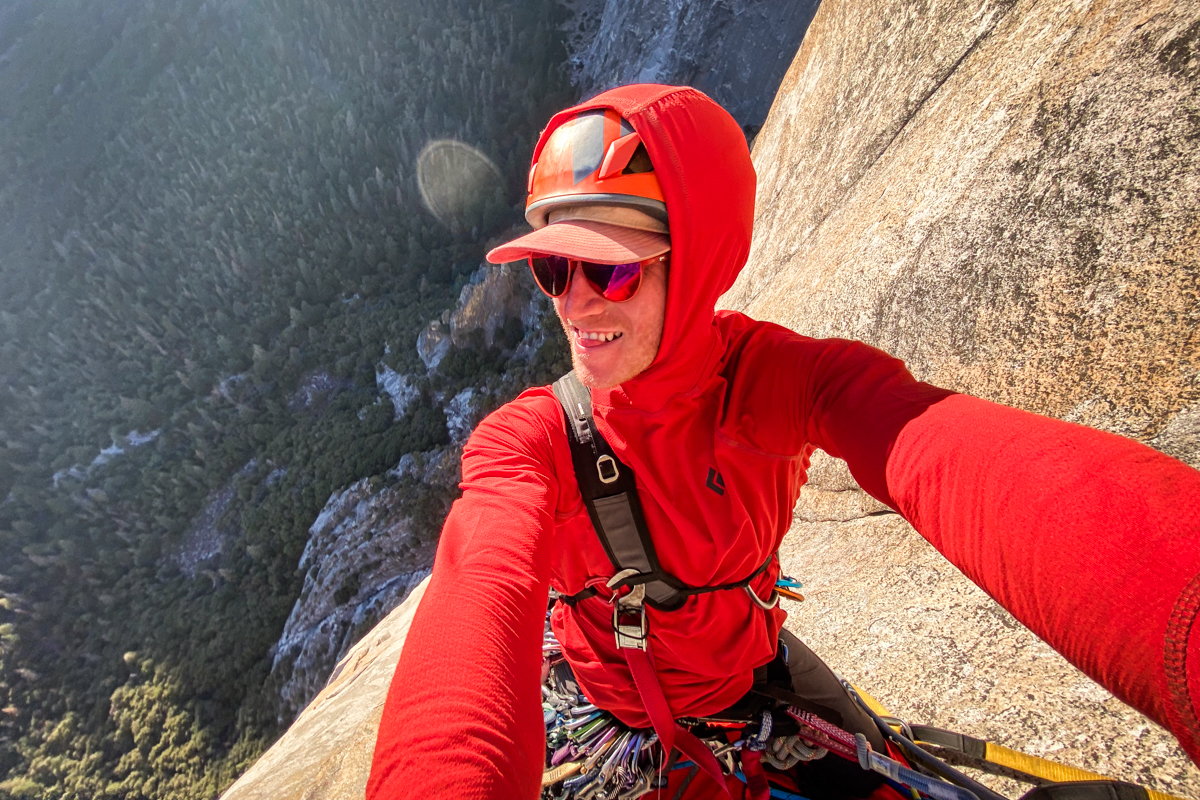
We touched on EPS and EPP foams briefly in the product descriptions above, but it’s worth going into extra detail about the differences between these two materials. After all, this barrier will be protecting the most important part of your body.
Expanded polystyrene (EPS)
Expanded polystyrene (EPS) has been the shock-absorbing foam of choice in climbing helmets for as long as we can recall. It’s very hard and functions incredibly well for absorbing a serious impact—once. EPS is known for crushing and fracturing when impacted. In fact, on some of the lighter-weight EPS models like the Petzl Meteor, the EPS foam is so delicate that it can fracture from simply being tossed down on the ground or stuffed under heavy gear in a climbing pack. Once EPS foam starts to show those fractures and fissures, its integrity is compromised. If you can see cracks on the inside of your helmet, it’s already time to replace it.
.jpg)
EPP (Expanded polypropylene)
Expanded polypropylene (EPP), on the other hand, is designed to absorb impacts without shattering. It’s the same material found in car bumpers and is more durable than EPS. We’re seeing more and more helmets with EPP in their construction—the Black Diamond Vision, Capitan, and Vapor, Petzl’s Boreo and Sirocco, the Mammut Wall Rider and Skywalker 3.0, and Edelrid Salathe in particular—and we’ve seen this number grow each year. EPP is so effective and durable that it technically does not need a polycarbonate or ABS shell, but many manufacturers incorporate a partial covering or crown for extra protection against falling objects and to improve both shape and appearance. The downside is that EPP helmets are more expensive, but they are more protective, durable, and lighter. If EPP doesn’t become the de facto material of choice for climbing helmets in the future, we will be very surprised.
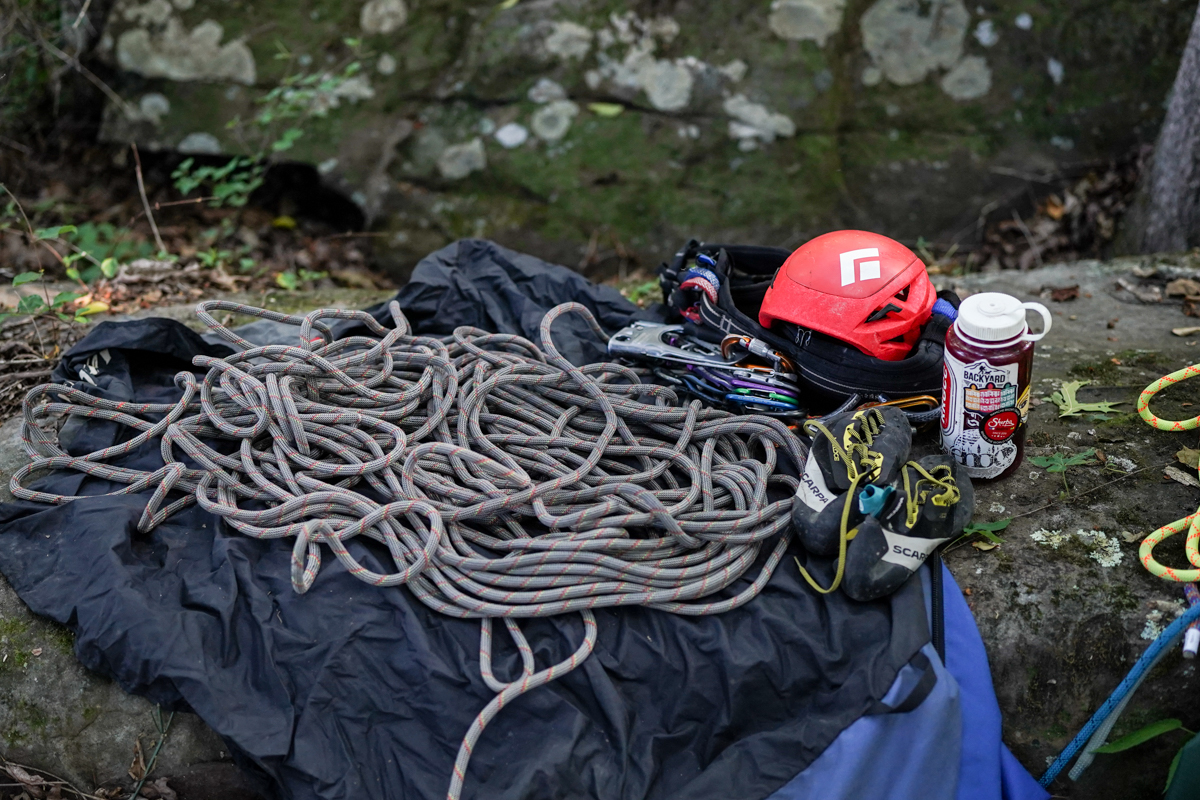
Now that we’ve covered the stuff on the inside, we’ll break down what protects it. We’ve mentioned some “hardshell helmets” with ABS plastic shells, such as the Black Diamond Capitan and Half Dome. ABS shells can absorb sizable impacts and protect well against any debris falling from above, and they’re also generally cheaper than other options. That said, they typically are thicker and more durable than polycarbonate shells, and that comes with added weight (which is why we mainly recommend them for cragging as opposed to multi-pitching).
For long days on the wall, however, opting for a helmet with a polycarbonate shell—or crown, like the Petzl Sirocco or Black Diamond Vapor—to shave weight definitely helps. That said, lighter-weight helmets always need to be treated with more care as they will damage more easily. For budget-conscious or new climbers who want more durability for their buck, a hardshell helmet will do the trick.
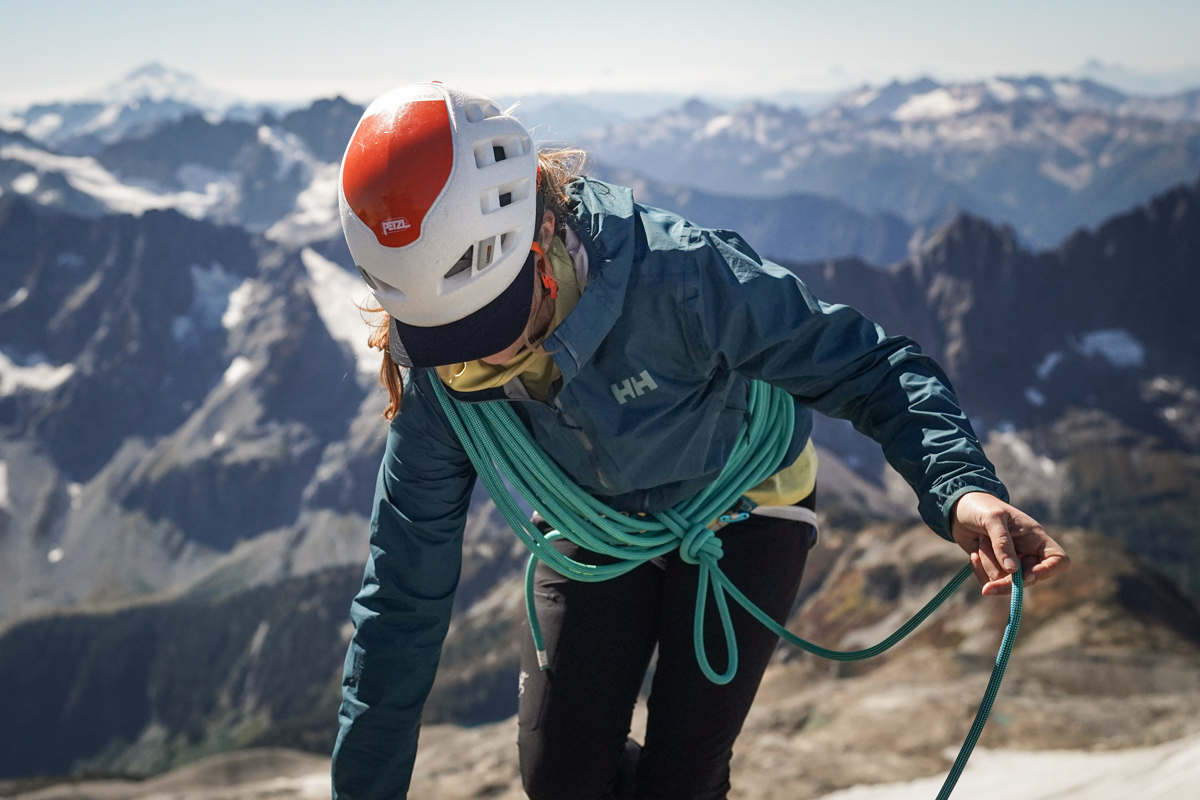
It’s widely accepted that a helmet is a mandatory piece of equipment for every alpine climber. The mountains are volatile, and objective hazards loom large. However, it’s our opinion that no matter where you’re climbing—in the mountains, at the crag, or even on lead at the gym—gravity (literally) is a force to be reckoned with. Rocks can fall even in popular, established areas; people can drop things; and whippers can result in head trauma. A helmet is always essential for your safety. Now that we’ve cleared that up, here are our recommendations for each type of climbing.
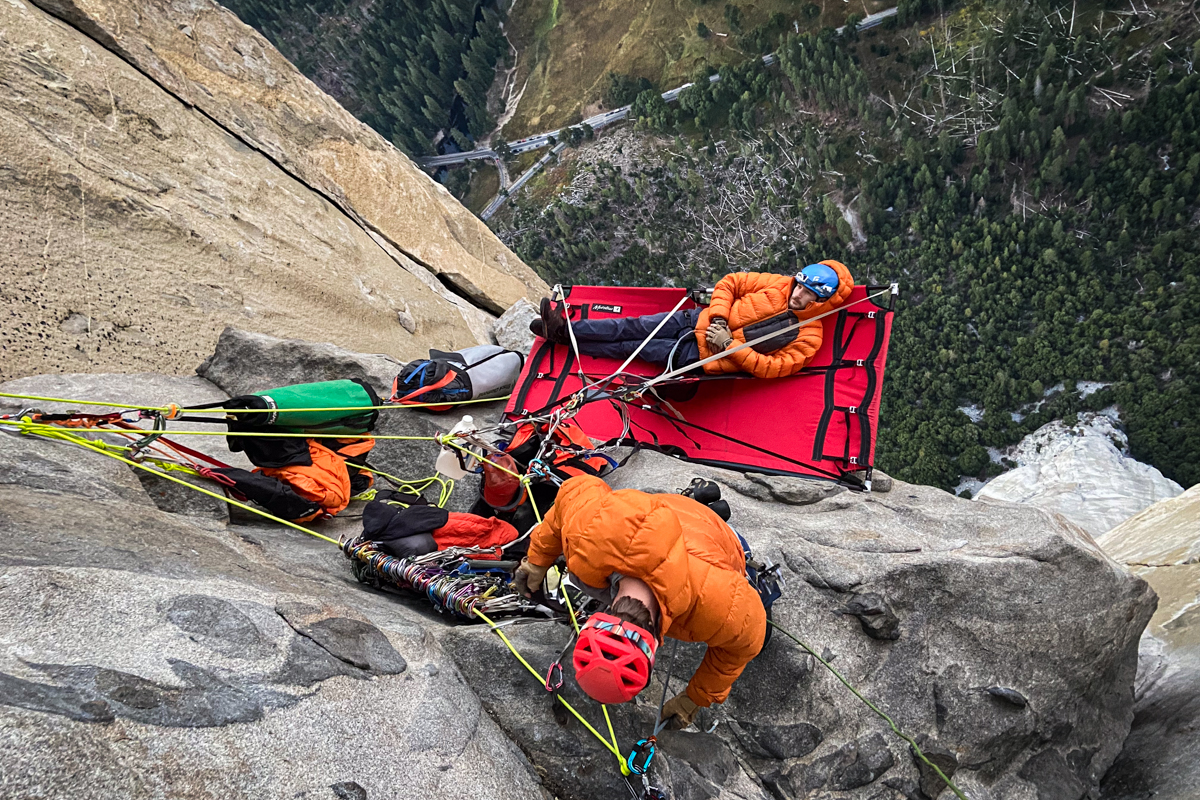
Alpine Climbing
This one is a no-brainer—virtually no one goes to the mountains without a helmet. Rock is loose, falls often aren’t clean, and snow and ice succumb to gravity, too. Because approaches to the mountains can be long, and you’ll likely spend all day wearing or carrying your helmet, you’ll want a lightweight bucket with suspension that packs down into it. Durability is also a crucial consideration here—there’s nothing quite as disappointing as having gear malfunction when you’re days from the car. Our top picks for the alpine are lightweight and durable helmets made with EPP foam, like the Petzl Sirocco and Black Diamond Vapor. If you get out frequently, the extra cost is worth it.
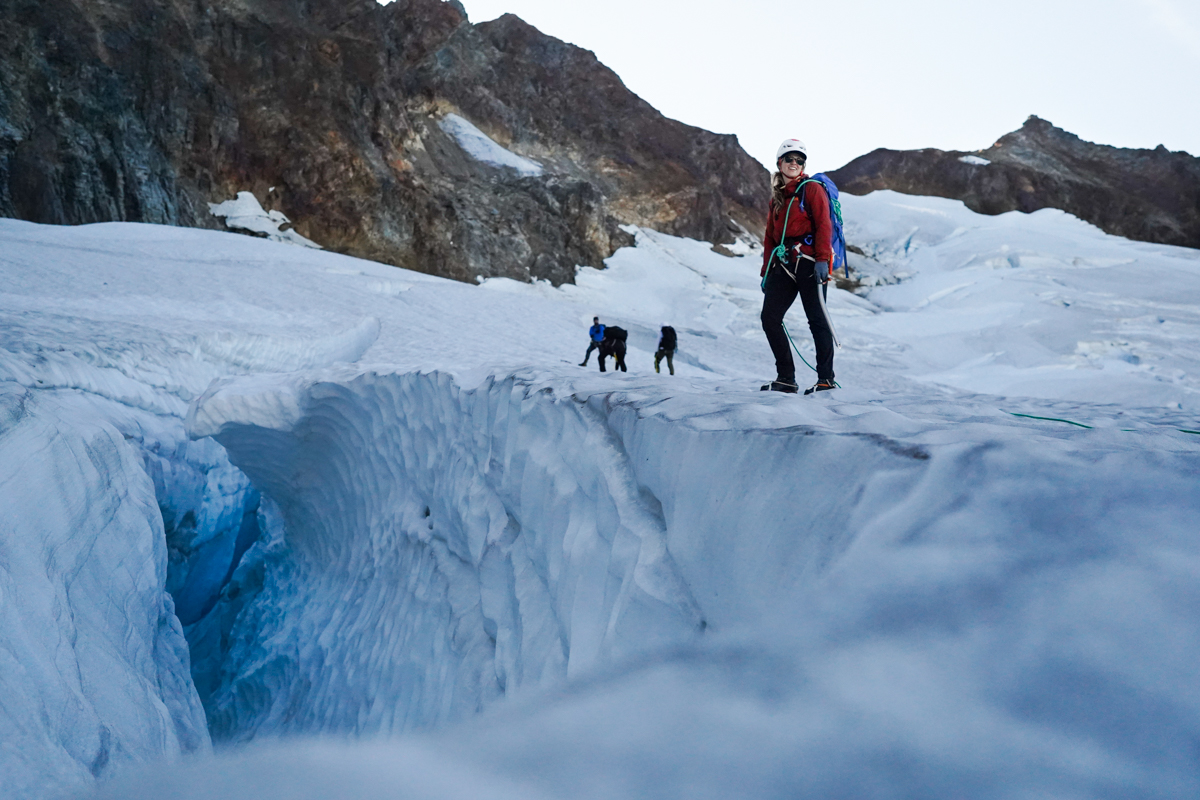
Multi-Pitch Climbing
For long days on the wall—think the Chief in Squamish or Black Velvet Canyon in Red Rock—you’ll want a lightweight helmet with good adjustability, ventilation, and comfort. Helmets made with EPP foam, like those mentioned above, are our top recommendation for multi-pitch climbing as well, but those on a budget can definitely get away with a slightly heavier, less durable build. Look for a helmet with a sub-10-ounce weight, a one-handed adjustment system (not something you'll find on the premium ultralight models, but a very nice feature), and a headlamp attachment. For long multi-pitch climbs, helmets like the Black Diamond Vision and Petzl Meteor are our top picks. You can get away with a helmet with a heavier ABS shell, but your neck might be feeling it at the end of the day.
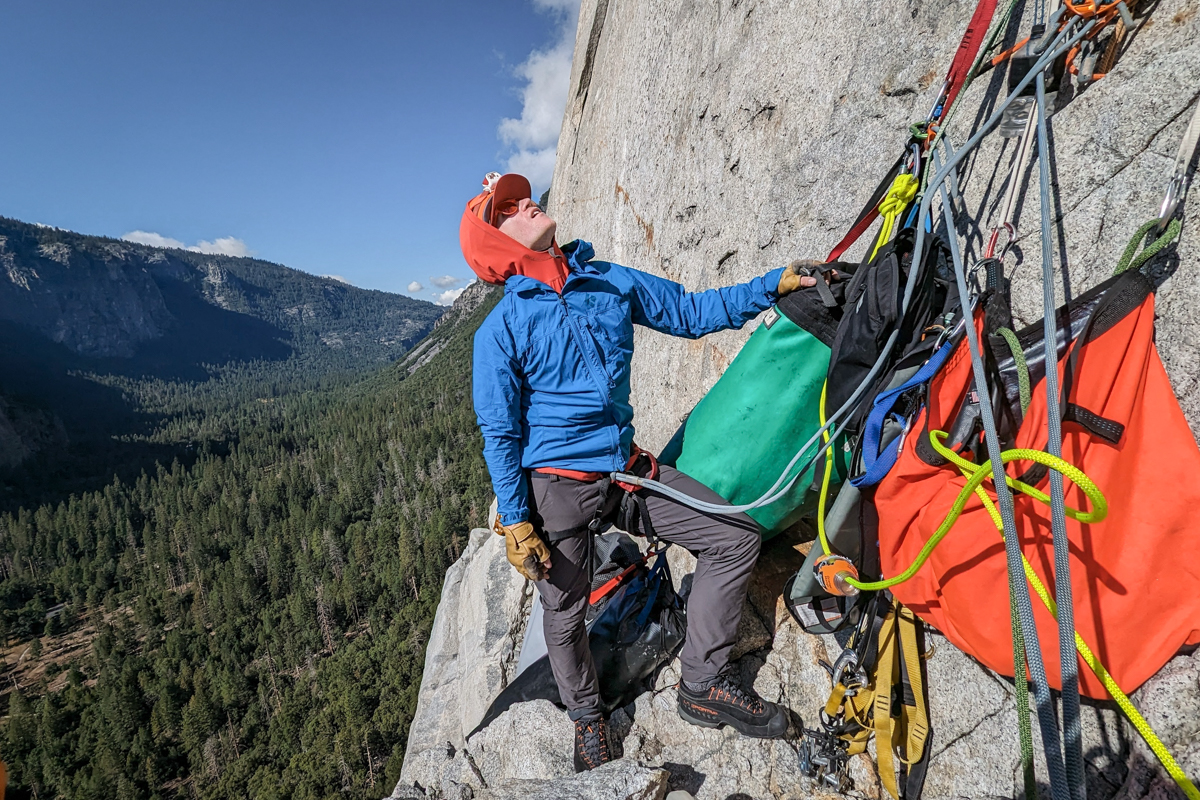
Cragging
We know too many people who leave their helmets at home for days at the crag (on single-pitch climbs), but there’s a lot wrong with that logic. You’re more likely to be climbing at your limit right off the ground, meaning you’re also more likely to be falling at the crag. And even when you’re hyper-aware of where the rope is running, you still can take a lead fall with a leg behind the climbing rope. When this happens, chances are high you’ll flip upside down and swing head-first into the wall. And this doesn’t just happen to new climbers unfamiliar with proper rope management. Several years ago, a well-known, helmetless climber was whipped upside down during a fall at Smith Rock—a crag notorious for bad rock and no head protection—and many locals since have changed their ways.
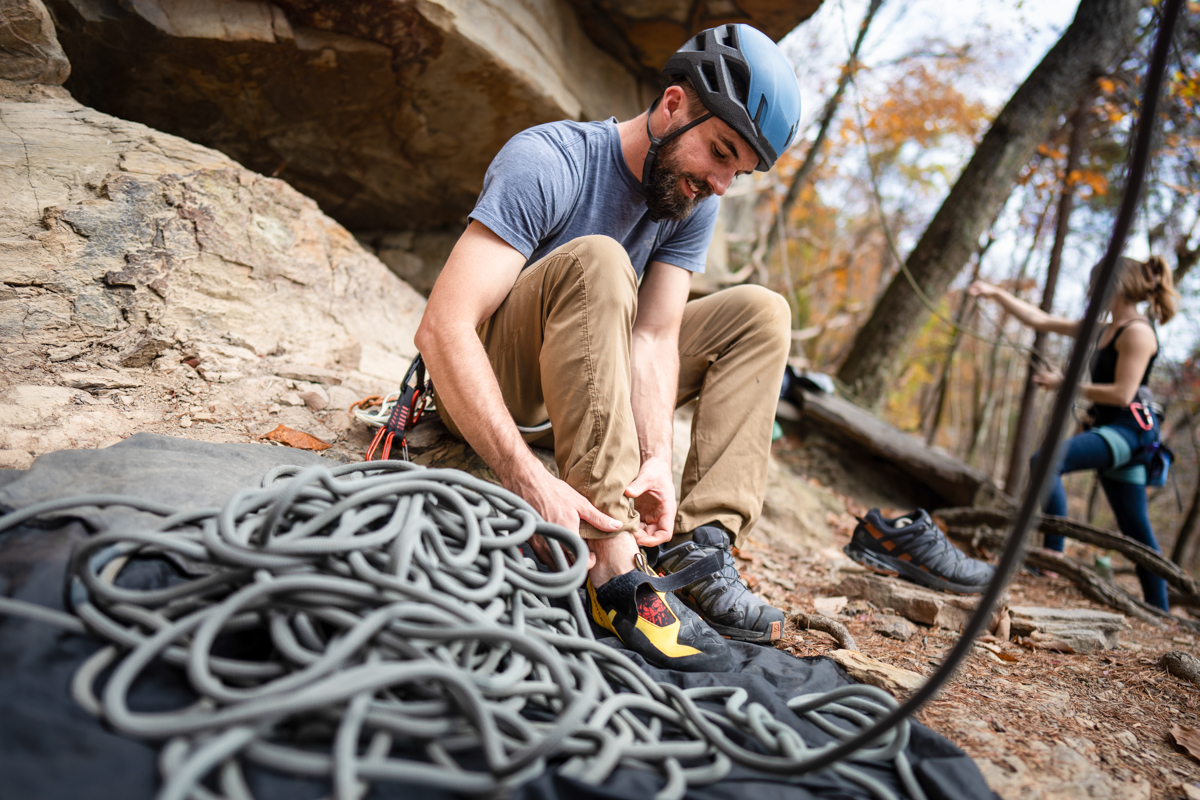
Ultimately, the decision is up to you, and if you do choose to wear a helmet at the crag, you’ve got some decisions to make. Are you pushing the grade? If so, you might want an ultralight helmet to go along with your lightweight harness and rope. Think EPP or EPS foam with a polycarbonate crown, like the helmets mentioned in the sections above. But because you’ll likely be taking your helmet off when you’re not climbing, most craggers can get away with a helmet that emphasizes durability and a lower price point above saving weight. Look for an ABS hardshell, a convenient adjustment system, and a sub-$90 price tag. The Black Diamond Capitan, Mammut Crag Sender, and Petzl Boreo/Borea are our favorite cragging options.
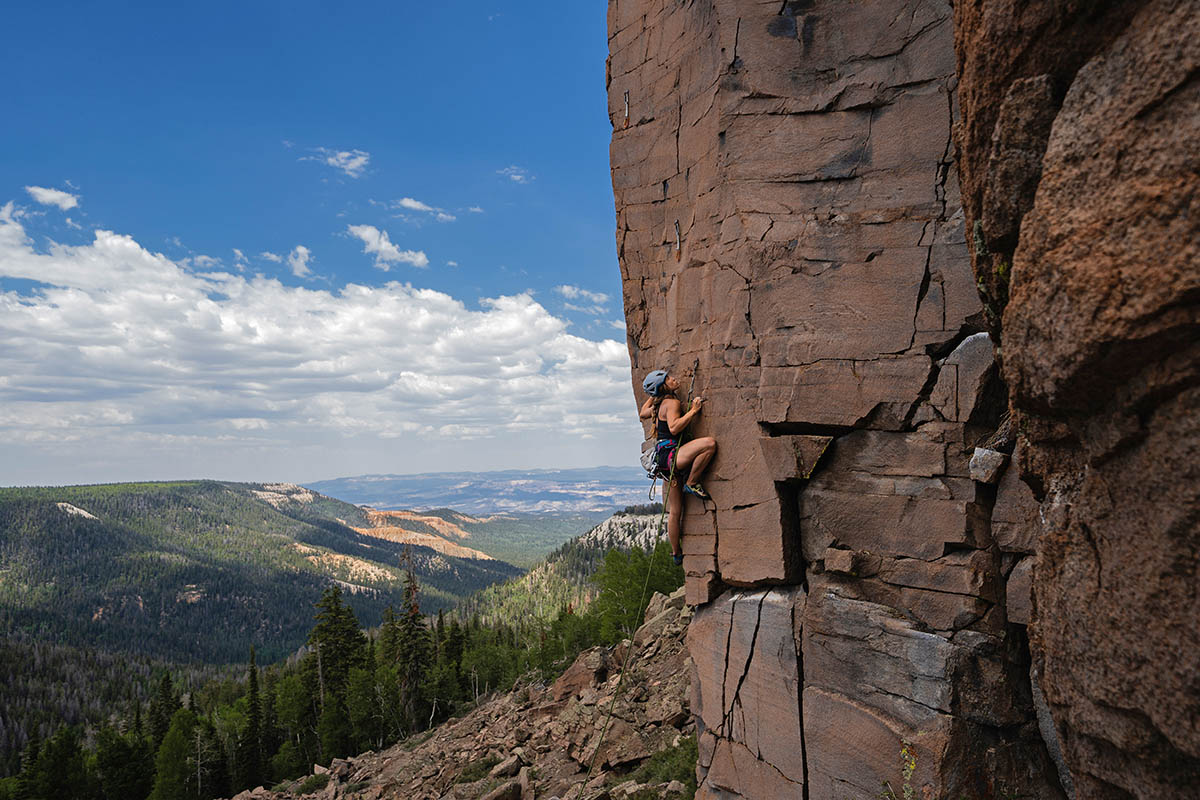
We’ll start by noting that all climbing helmets are guaranteed by an international standard (if you’re curious, the UIAA 106 and EN 12492), which means they all meet certain safety requirements. However, there is some variation in the amount of impact protection each model provides. The first factor is the type of foam, which we detailed above. To summarize: EPP foam will absorb impacts, whereas EPS foam will shatter. Therefore, when it comes to EPS foam, a cracked helmet is a retired helmet. EPP lids, on the other hand, can take a licking and keep on ticking, meaning EPP is far and away the more protective choice.
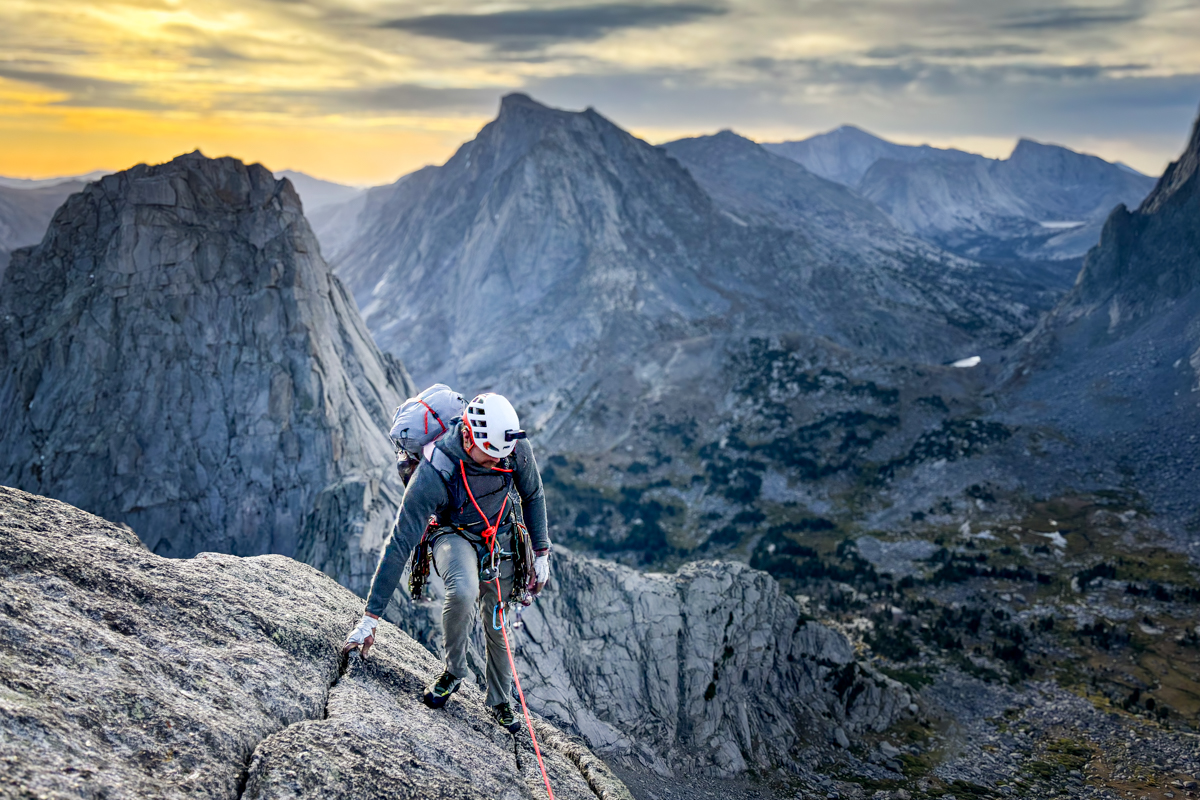
The second factor—and this is a big one—is which part(s) of your head is protected by the helmet. Thanks to the UIAA and EN, all helmets are built to take impacts from above, which usually come in the form of rockfall. However, only some provide adequate protection at the front, rear, and sides. This wraparound coverage is especially important if you’re a lead climber, as it’s not uncommon to flip upside down when taking a fall. Rumor has it that there is a proposed UIAA standard for around-the-head protection, but for now, we look for companies to call it out in their product specifications. For example, the Black Diamond Vision features increased fall protection, and some Petzl models are certified to their “Top and Side Protection” standard (like the Sirocco, Boreo/Borea, and Meteor).
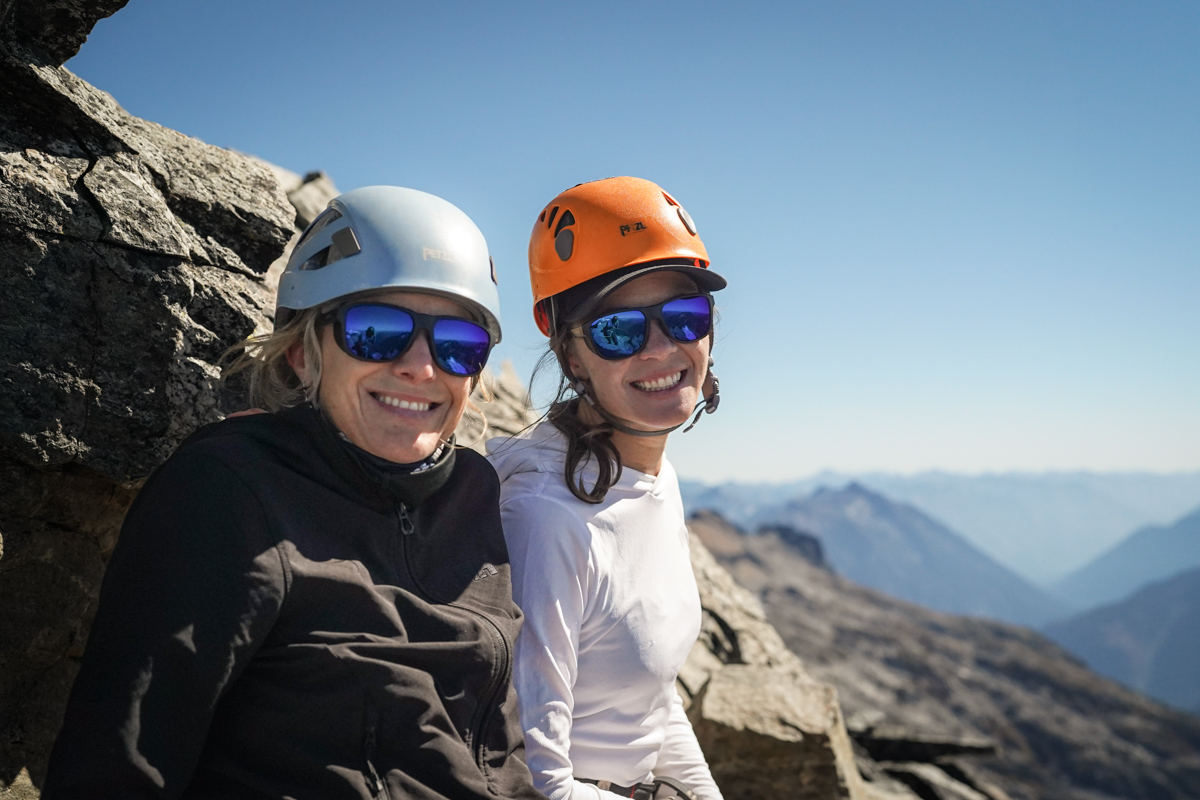
Finally, MIPS has finally made its entrance in the climbing world, most notably with the Black Diamond Vision and Capitan and the Mammut Wall Rider. Widely used in ski and bike helmets, MIPS (which stands for Multi-Directional Impact Protection System) provides extra protection by creating a low-friction layer between the helmet’s shell and soft liner. The intention is that when hit at an angle, the MIPS layer will allow the shell to move just enough to mitigate the rotational forces on the head and brain. In other words, the MIPS insert absorbs some of the impact. You’ll pay $40 to $60 more for it (the Black Diamond Vision MIPS is $150 compared to the standard version’s $100), but for some, the added assurance is well worth it.
Aside from safety, one of the most important traits in a climbing helmet is comfort. If it’s not comfortable, you won’t wear it. And if you don’t wear it, it won’t protect you. Comfort is subjective and depends a lot on the shape of your skull. For example, the biggest critique we’ve heard about the Petzl Sirocco is that it doesn’t fit comfortably on larger heads. As with most climbing equipment, your best bet with helmets is to physically try them on before buying. That said, we haven’t noticed huge variability in comfort between different companies, but we’ve definitely seen it between models. And almost without exception, heavier means less comfortable, and lighter is better.
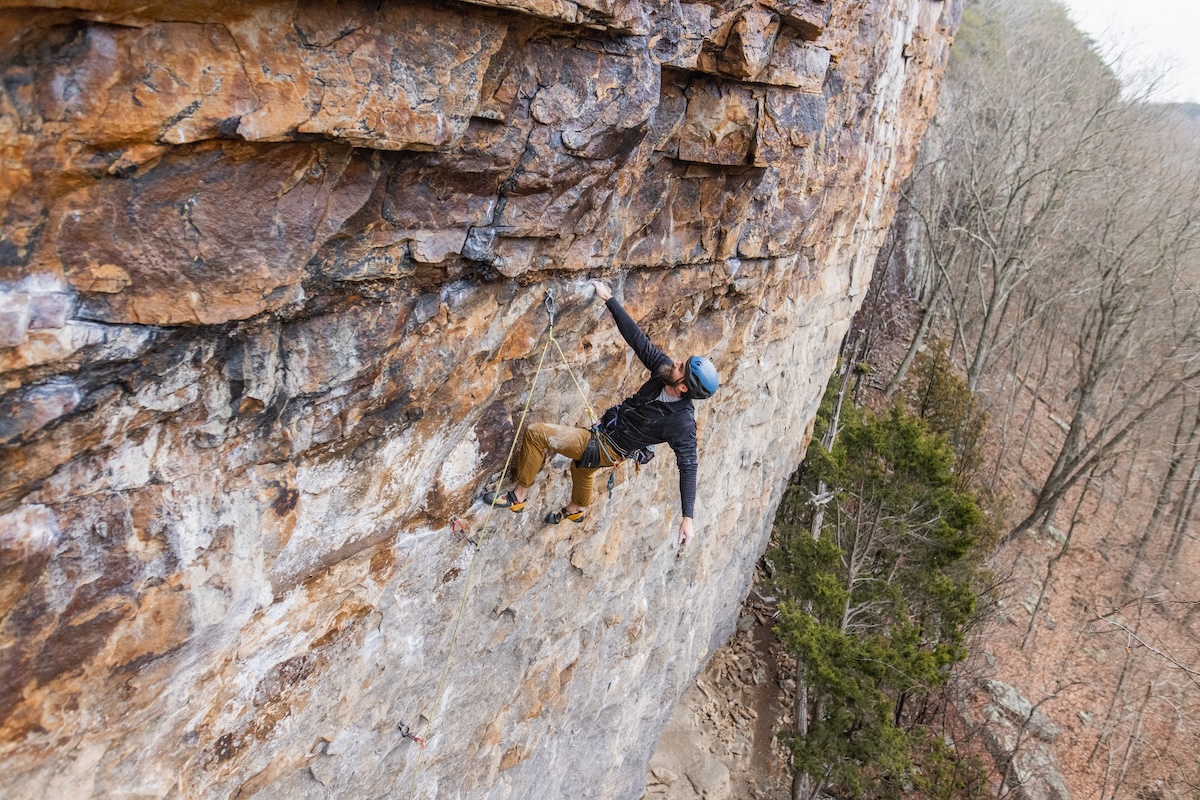
A good climbing helmet should fit snugly but comfortably and shouldn’t bob around much when you move your head. When guiding, we always ask our youngest clients if they like ice cream, provoking them to nod emphatically. If the helmet fits, it won’t move while they express their love for tasty cold treats. If it bobs up and down or comes to rest with their forehead showing, we tighten up the rear adjustment and chinstrap. And if the helmet just floats on top of the head more like a yarmulke than a baseball cap, it’s too small.
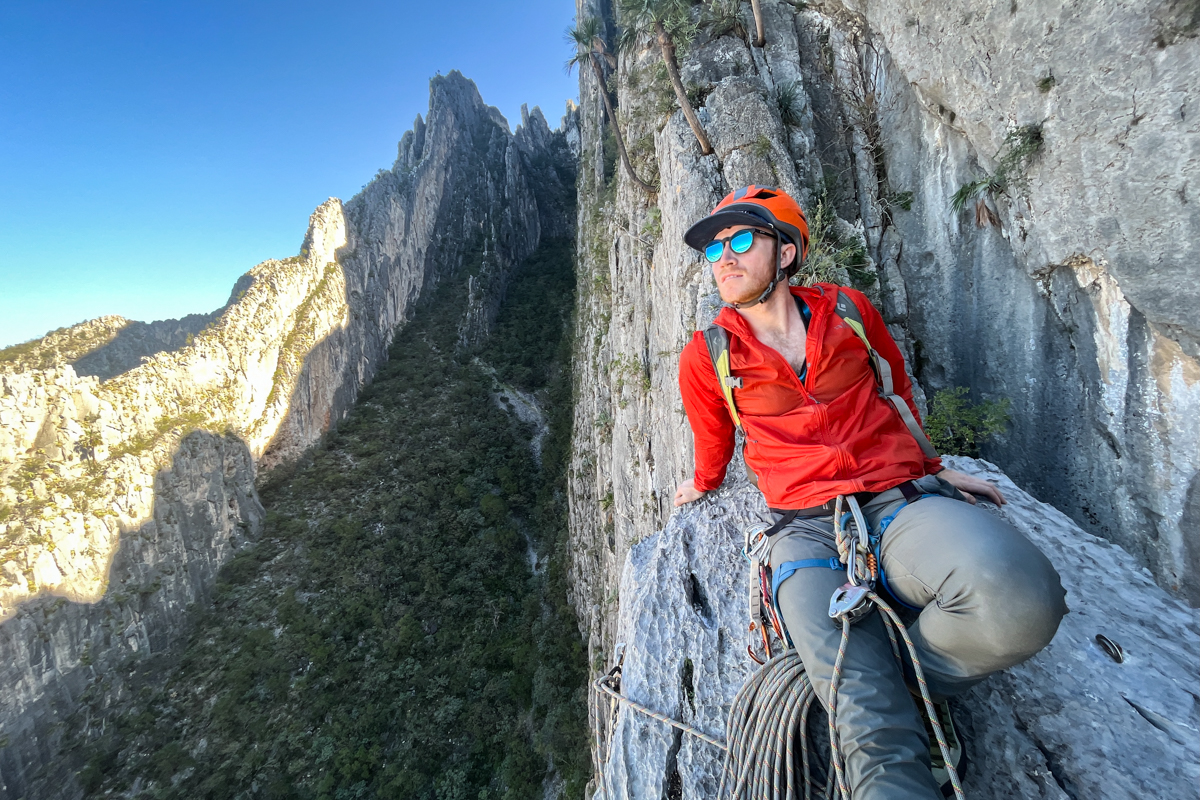
Most climbing helmet models are available in two sizes, and there is usually some overlap between one size and the other. If you are near the cutoff point for either, we suggest you try the helmet on before buying (although this is never a bad idea, regardless). In terms of adjustments, all climbing helmets offer two straps: one around the head and one around the chin. Some helmets, like the Sirocco—usually those that emphasize weight—have a strap and buckles to adjust the head strap. Others, like the Black Diamond Capitan, offer a two-sided plastic ratcheting system, which is meant to be adjusted using two hands. The Black Diamond Half Dome offers a really simple one-handed adjustment system using a circular knob that tightens when turned in one direction, and loosens in the other. In general, we've found that the most expensive helmets are the hardest to fit (due to their streamlined suspension), while the most affordable helmets are snug, well-fitting, and easy to adjust.
.jpg)
A few helmets on our list offer women’s models, notably the Black Diamond Half Dome, Petzl Borea, and Petzl Meteora. These women-specific versions are set apart by one main feature: a “ponytail-friendly” shell and suspension system, which means an upward curve at the back of the head. For the most part (and this is coming from a ponytail-wearing woman), this doesn’t seem like a particularly necessary feature, though some women will appreciate the thought. But in general, climbing helmets are a unisex piece of gear and accommodate all kinds of head shapes, sizes, and hairstyles.
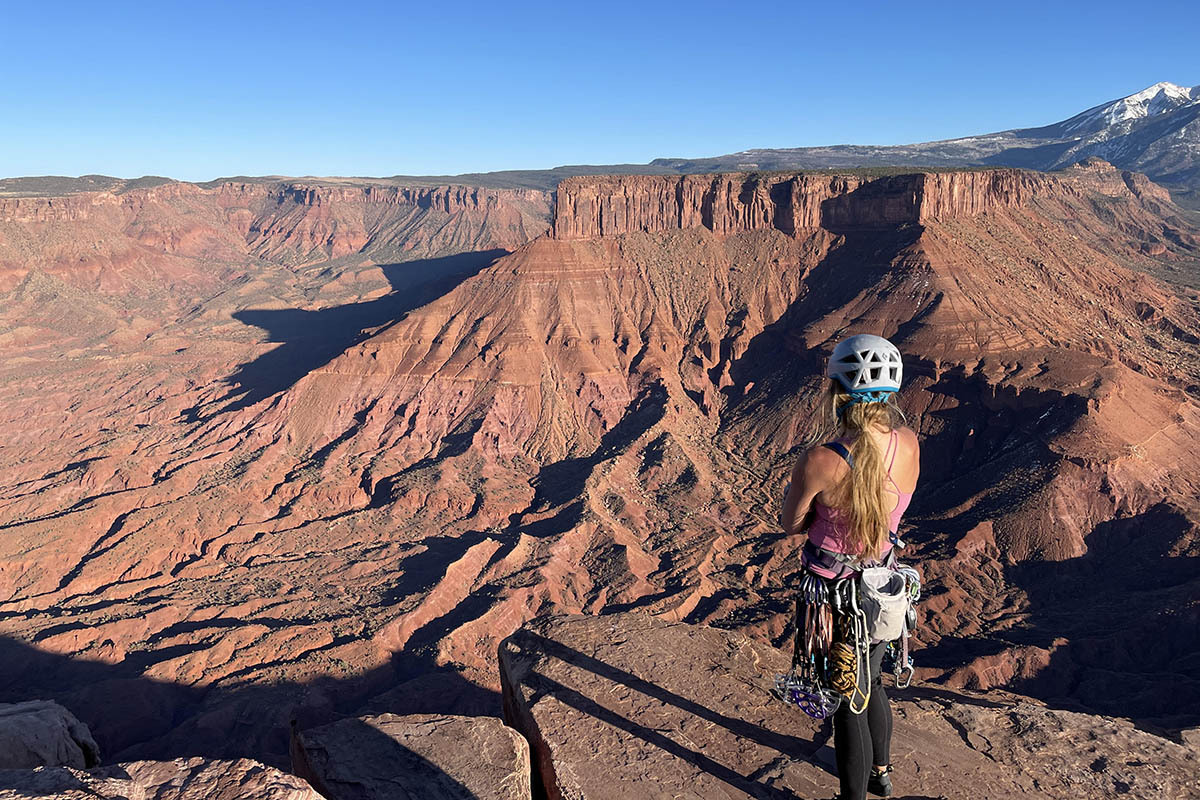
In the past, one of the main complaints we had about climbing helmets was that they didn’t breathe well enough, making our heads sweaty, hot, and uncomfortable. As technology continues to improve, we’ve seen helmet manufacturers add more and more ventilation. While we’re excited about the trend, it is worth mentioning the inherent disadvantages of greater ventilation. More vents mean more empty space and less material protecting your head. It’s possible, although pretty darn unlikely, for a thin and narrow rock or ice shard to sneak through. And if you’re primarily a winter or cold-weather climber, ventilation may be more of a drawback than an advantage. All in all, we think that helmets like Petzl’s Sirocco and Meteor strike a nice middle ground of protection and breathability.
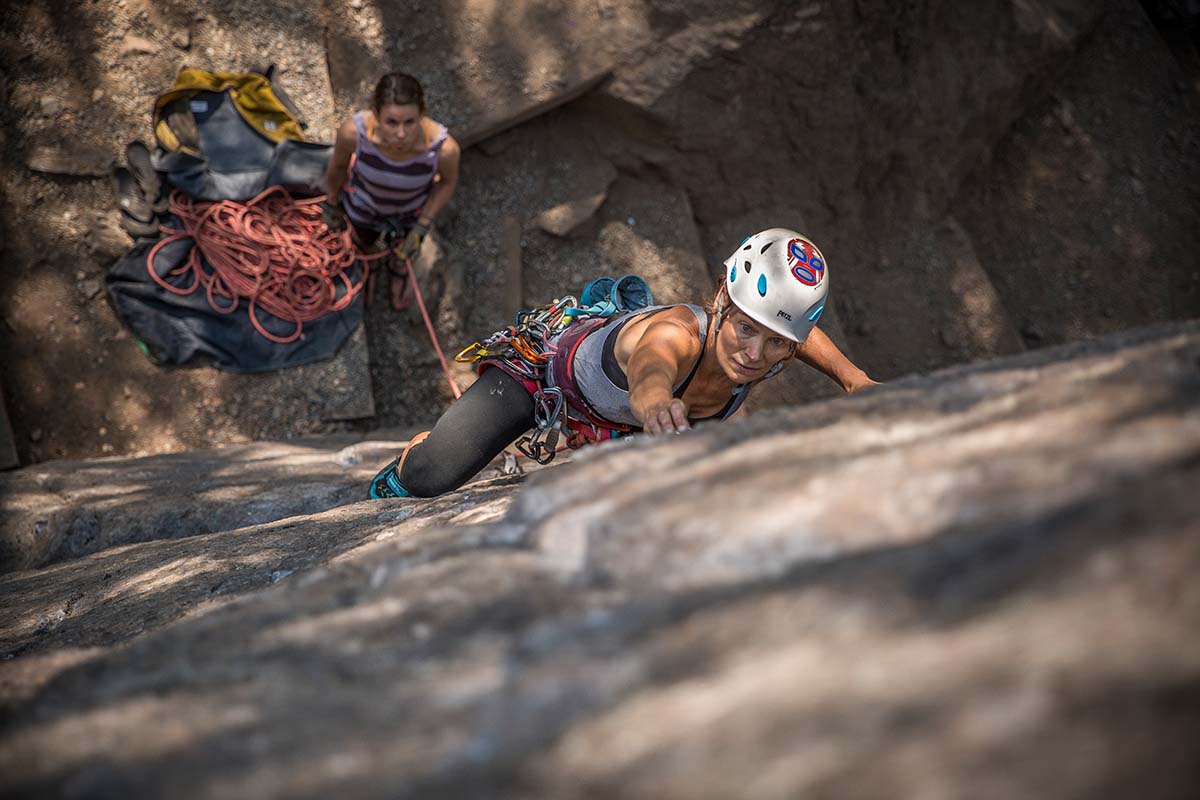
The helmets on this list weigh in anywhere from 5.5 ounces at the low end to 12.4 ounces at the high end, and there are even heavier models out there that didn’t make the cut. While 13 ounces (less than 1 lb.) seems like a paltry amount to complain about, it’s still more than twice as heavy as the lightest helmet available. The truth is, these ounces can add up quickly. In any kind of multi-pitch climbing scenario, or even on long cragging days, the helmet goes on in the morning and doesn’t come off until the end of the day. Personally, we like our helmets to be as feathery as possible. Lighter helmets also ride less on the neck and don’t seem to shift around the head as much when looking up and down.
.jpg)
Typically, weight and durability are inversely correlated with climbing gear (or any type of outdoor gear). In other words, the lighter the gear, the less durable it will be. In the world of climbing helmets, however, this pattern doesn’t always hold true. Helmets made with EPP foam, like the Petzl Sirocco and Mammut Wall Rider, are among the lightest and most durable on the market. Remember, EPP foam is made to bend and absorb impact, whereas EPS foam fractures in order to handle blunt force. Among EPS designs, those with an ABS hard shell will withstand wear much better than those with a polycarbonate shell.
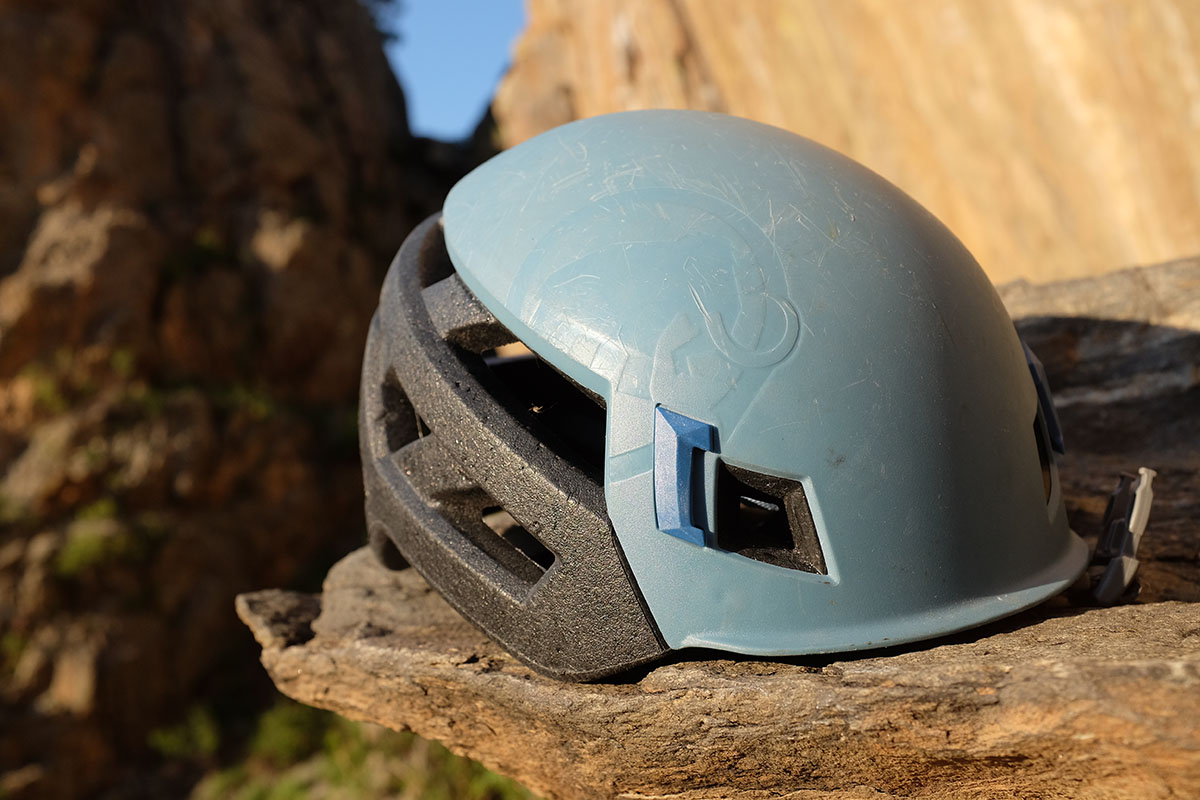
Once you’ve chosen your helmet, it’s important to know how to gauge its wear and tear. In general, one fall or impact is enough to end the life of an EPS-constructed helmet—any sort of crack in the foam means that your helmet’s safety is compromised. But the tricky thing is, not all fractures are visible (some lie on the inside underneath the polycarbonate or ABS shell). To check, look for major dents on the shell as a good marker of internal damage. It’s also important to inspect the webbing and suspension system, buckle, and, in the case of ABS helmets, the sturdiness of the foam’s attachment to the shell. On the other hand, because EPP does not fracture in the same way as EPS, these models are exempt from the “replace your helmet after impact” rule. Nevertheless, you will want to continue to inspect the foam. Given its partially exposed nature on helmets like the Sirocco and Wall Rider, this should be a rather straightforward process.
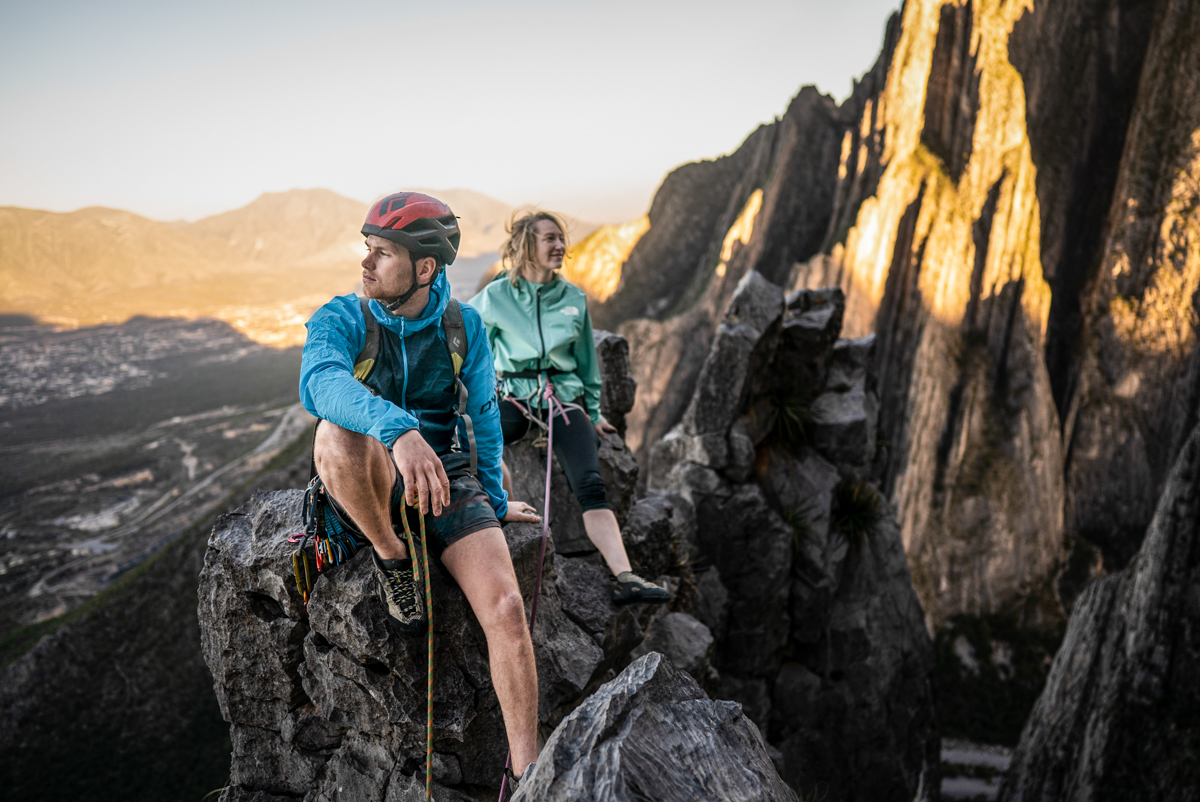
We would be hard-pressed to find a climbing helmet that does not claim to be headlamp-compatible, so it’s pretty much a given. That said, some helmets hold a headlamp better than others. For example, the convenient rear strap on Petzl’s Sirroco and Black Diamond's Capitan is a breeze, while the attachment points on Grivel’s Stealth, which we've tested in the past, are rather difficult to use. Some clips are even removable to save weight, but popping these pieces in and out of the foam may loosen and weaken the attachment points over time. The bottom line is that any helmet you buy will be headlamp-compatible—just study the system used for securing the headlamp before you make a purchase.
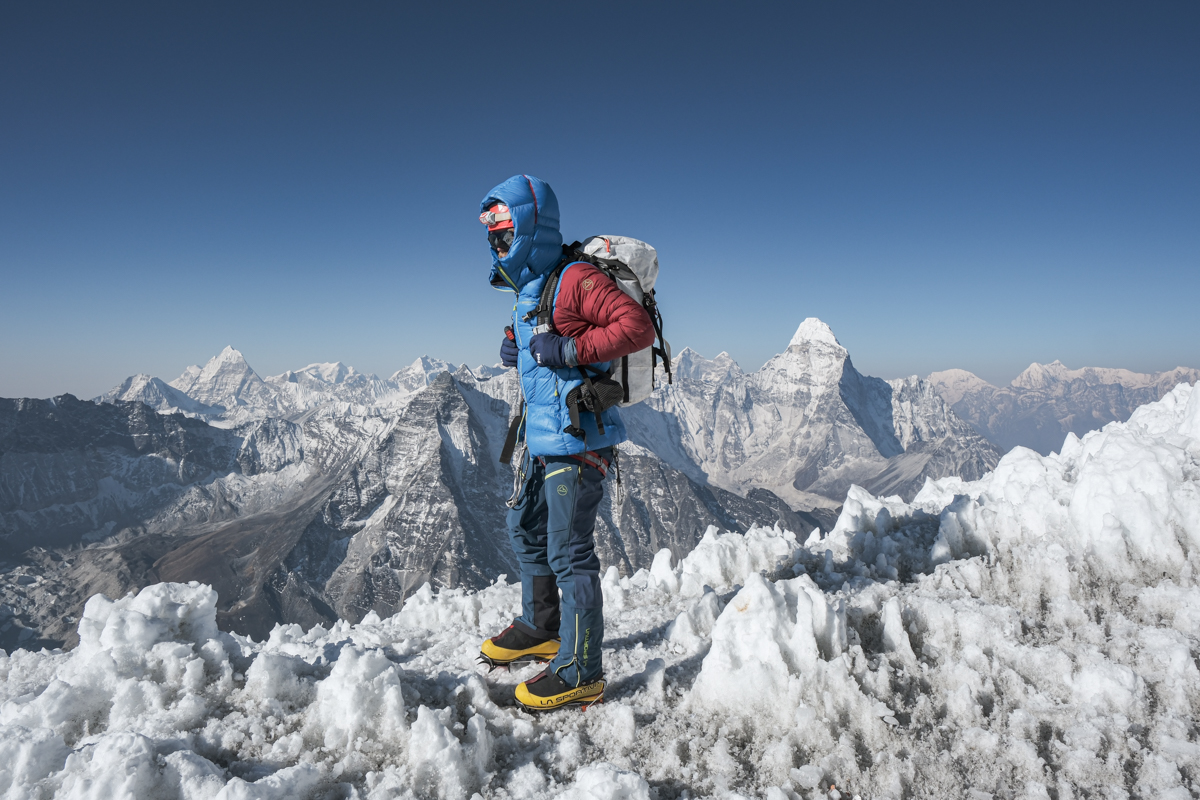
Many weight-conscious skiers will opt for a climbing helmet for fast-and-light days in the mountains, but only a few are actually designed and certified for both skiing and climbing. These helmets provide more coverage than climbing helmets, protecting against impact from the side, front, and rear as well as the top, and also are compatible with ski goggles.
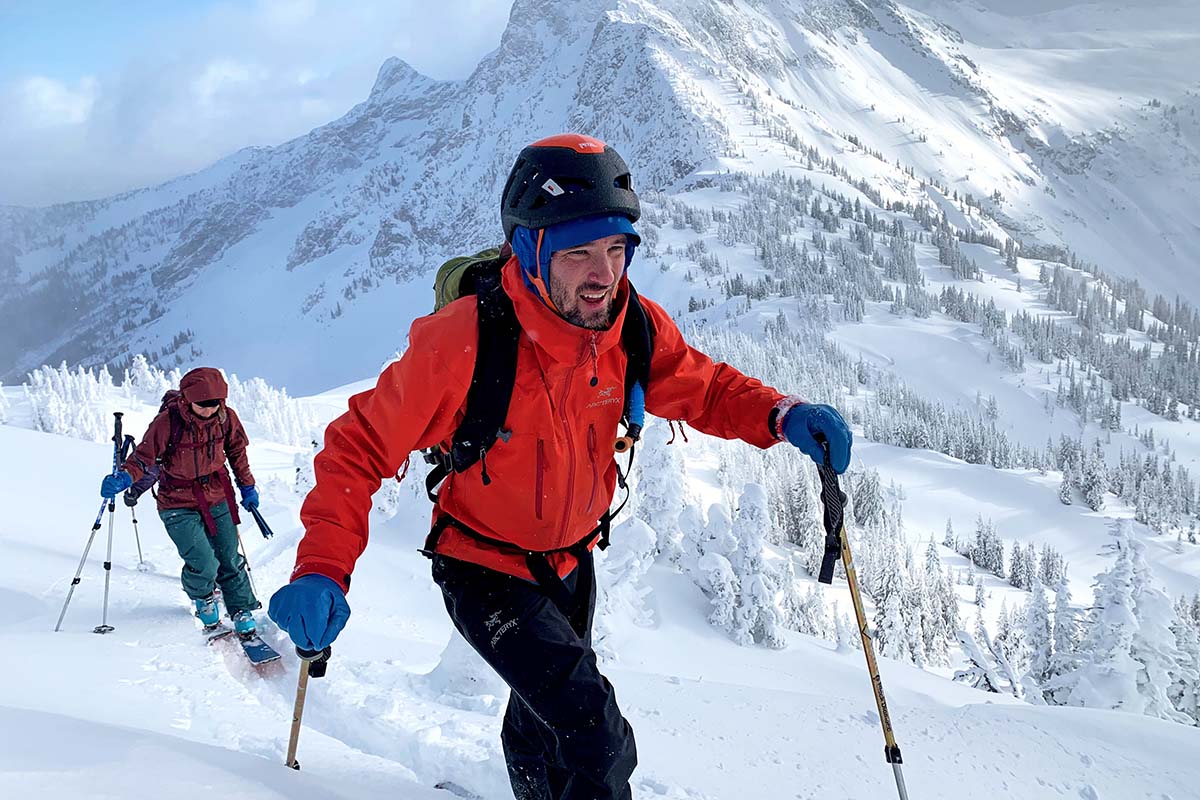
If you’re looking to use your climbing helmet for skiing, there are a few ratings to know about first. First off is the CE rating for ski touring (CE casque de ski de randonnée), which was debuted in the Petzl Meteor and certifies helmets for use while ski touring (read: moderate backcountry skiing and ski mountaineering). Second is the EN 1077 rating (seen in the CAMP Speed Comp): the European standard for snow-sport helmets and a badge given to more protective designs that can be used for alpine (resort) skiing and skimo racing. If you’re looking for a climbing helmet that can double as a lightweight ski helmet, it’s important to be aware of the distinctions between these two certifications.
Back to Our Top Climbing Helmet Picks Back to Our Climbing Helmet Comparison Table